
- Life@Home >
- Life@Home Articles >

Leaving on a Jet Plane: Flying with a PD Cycler or NxStage System One

Plan Ahead for Your Treatments
With a bit of up front planning, your whole trip can go more smoothly.
Sort Out Your Supply Shipping
If your trip will last more than a day or two, you’ll most likely need to ship dialysate and other supplies. These will need to be in their company boxes with labels on them. Talk to your care team as you plan: your nurse will need to place your supply order . You’ll want to have this chat well before you want to fly —and before you buy plane tickets:
You will need at least 2 weeks notice to get free supply shipping in the continental U.S. with Fresenius (800) 323-5188.
Reference: Traveling on dialysis. https://www.freseniuskidneycare.com/thriving-on-dialysis/traveling (Retrieved 03/03/22).
You will need at least 6 weeks notice to get free supply shipping in the continental U.S. with Baxter (800) 284-4050.
Reference: Traveling with peace of mind. https://kidneycampus.ca/wp-content/uploads/2019/03/travel_brochure_2019_en.pdf (Retrieved 03/03/22).
Travel outside the continental U.S . may need 6-8 weeks lead time—or, more— depending on where you want to go. And, you must pay to ship your supplies.
With less lead time, you will have fees to order and deliver supplies. You’ll need to pay these fees in advance. If your plans change, there may be a change order fee . Week-end, evening, holiday, and special delivery can add costs, too. Call your supply company to get details for your trip. Some people find their own carriers to ship supplies. This is more work—but can be a way to cut costs. People have done this for trips to Hawaii, the Dominican Republic, Aruba and other Caribbean sites, and Europe. Or, it may be less costly to rent a NxStage machine in a country you visit, if this is an option there.
Wherever you plan to go, your nurse will need to know:
Your travel dates
How many supplies you will need. (Allow for some extras).
Your hotel name, address, and confirmation number, if you will stay in one
The address and contact info for your lodging if it is not a hotel
Then, it is your job to follow up and be sure all has gone as you planned:
One week before you go , call your supply company to be sure your order was sent.
Call again, just before you leave , to see where your shipment is.
If you take a cruise, confirm that your order is on board before you leave the dock.
Call your hotel to be sure your order is there . Confirm that they have the right number of boxes, and the right boxes. (See if they will send you a label photo.)
No hotel? Call your supplier and the carrier. Confirm the date and time that your shipment will arrive. Ask them to call you that morning and when they are 30 minutes away. If they don’t call, check with your clinic or supplier. You don’t want to waste travel time chasing down your supplies!
Be sure your machine is insured for damage or loss . Talk to your clinic, your homeowner’s plan, and the company. A travel health plan is wise no matter where you go, and these don’t cost much. If you leave the country, it is a must-have.
Arrange for Backup Care
Find a nearby back-up center in case you forget something or have a problem. Your home training nurse or social worker may help find one. Know where the hospitals are, too.
A PD Cycler or NxStage Machine Flies for Free

Your machine is an "assistive device" (Section 382.3).

Your machine does not count toward a carry-on bag limit (382.121(b)).
If you pre-board and check your machine, it takes priority over other bags if space is tight (382.123(a)).
The airline cannot charge you a fee for your machine in the cabin or as checked luggage (382.31(a)).
Your machine must be portable (100 lbs. or less with the case) (382.1(c)).
If the airline loses or harms your machine in the US, baggage liability limits do not apply . They must pay for your machine based on its price (382.31). NOTE: Outside of the US, the limit is $1,685—far less than the machine costs.
The airline must let you bring your medicines, syringes, and dialysate. (382.2). But...just a 1-2 day supply . Any more, and you will need to ship it.
You can't use your machine during a flight. It has not been tested and could affect the plane's navigation or communication (382.121(a)(3)).

Other Fees and Costs
Hotels Charge Fees to Receive Packages
If you will stay in a hotel, call and ask to talk to the Bell Captain or a manager. Explain that you will send life-saving medical supplies for your stay. Ask if they will waive the fee to receive and store your boxes. If not, see if they will charge one fee for your order. (You don’t want to have to pay for each box.) Ask them to send you a letter or email if they say they will help you.
Bring Cash for Tips
You may need help to move your machine or supplies from place to place. A tipping rule of thumb is $1-2 per suitcase (or box), and $5-10 for a machine (based on weight). Think through your trip to figure out how much to bring. You may need to tip someone to :
Load up supplies at home to get to the airport
Unload at the airport to get supplies on your flight
Pick up supplies from baggage claim and get them to a taxi or shuttle
Unload supplies and bring them in to your lodging
Bring supplies up to your room if you stay in a hotel
Note : Some airports don’ have Skycaps to help you with heavy luggage. Or, Skycaps may not work all the time. Look on an airport’s website or call ahead to find out.
A Week Before You Fly…
Taking two simple steps before you leave can make your travel go more smoothly:
Call the airline’s Disability* Desk . Ask them to add a note to your travel file to say that you will bring a dialysis machine. Tell them how much the machine weighs in its case. A NxStage System One in a hard case weighs 99 lbs. PD cyclers weight much less.
Ask for a wheelchair when you call , even if you do not use one. This alerts the counter agent that you have special health needs. Note : You and your travel partners will get through the TSA faster, as wheelchairs go to the head of the line. You can pre-board the plane, and it will be easier to change planes. And, the airline staff can help you find a Sky Cap when you get to Baggage Claim.
*This desk may be called Accessibility .
What to Pack for PD or Home HD
To pack for dialysis travel, make a list as you do each treatment for a few days. Ask fellow travelers for tips—most are happy to share their thoughts.
A PD Cycler or NxStage Machine
Measure your machine in its travel case. A PD cycler may fit on a plane as a carry-on. If not, it will need to be checked. A NxStage System One can only be checked luggage. You can check one bag of supplies for free . It must fit the airline’s baggage size and weight rule, and can contain only medical supplies.

Treatment Supplies
You may want to fill a large Ziploc bag of supplies for each treatment you plan to do. Some centers will add the bags to your supply orders, so ask. Pack an extra bag and spares such as gloves, tape etc., so you don’t run short. When all else fails, bring duct tape! Camping clips (called carabiners) can let you hang bags if you don’t want to bring an IV pole. An electric heating pad will let you warm PD bags.
Medications and Syringes

Bags go astray. It doesn't happen often—but it does happen. (When it does, bags most often arrive on the next flight). Pack medicines in a carry on —never in a checked bag. Airplanes do not have refrigerators. If you have a drug that must be kept cold, check into “micro” coolers for this purpose. Most cost less than $20.
There is no limit to how many empty syringes you can bring. But, you must also bring the drug you will use, like EPO. The drug must have the original, printed label.
Paperwork You Will Need
Besides an ID and your hotel and flight plans, bring along:
Your airline’s policy for dialysis machines. Look on their website for “Disability.”
The DOT rules for dialysis machines on airplanes
Your dialysis prescription
The phone number for your home clinic
Your most recent lab test results
A recent hepatitis B or C test
A list of all of the prescription drugs you take now and the dose for each
Your supply order for the trip and where you plan to go
A phone number for any clinics or hospitals you might need to call as back up.
Any hotel proof of how much they will charge you to receive packages.
Checking in at the Airline Counter
As you now know, you have the right to bring a machine and a bag of medical supplies for free . If a counter staff person wants to charge you, follow these steps:
Stay calm and give the facts . Show the staff person the DOT policy.
If this does not help, write down the agent’s name (for a later complaint). Ask for a supervisor or a CRO (complaint resolution official). Get the CRO’s name as well.
If the CRO doesn’t help, call the airline’s disability desk while you are at the counter.
Or, from 9am-5pm Eastern time on weekdays (not holidays), call the DOT hotline: (800) 778-4838 , and (800) 455-9880 for TTY. Their CROs know the Part 382 rules.
Search Facebook for the airline’s page, and post a complaint while you are still at the counter . Be clear and concise. Someone at the airline may be able to help you.
Still at a stand-off or kept at the counter for a long time? Pay the fee (if you can), keep the receipt and notes, and file a DOT complaint when you get home:
Online: https://www.transportation.gov/airconsumer/file-consumer-complaint
Or, write to: Aviation Consumer Protection Division, C-75, U.S. Department of Transportation, 1200 New Jersey Ave. S.E., Washington, D.C., 20590.
Getting Through Airport Security
If it has been a while since you flew, some things have changed:
You can go to a gate only if you have a ticket for a flight that day .
You need a boarding pass and an ID . A passport always works as an ID. Trusted traveler cards from the U.S. government (e.g., Global Entry, Nexus, Sentri, FAST) work, too. NOTE : As of 2018, a driver’s license only works in half of the U.S. states: https://www.dhs.gov/real-id .
Airlines use X-rays to screen luggage . You'll put your carry-on bags on a belt to go through the X-ray. A laptop and a Ziploc bag of liquids must each go through in its own bin. An outer jacket goes in a bin, too. The X-ray won’t hurt your machine . A heads up to the TSA agent before you go through the line may help avoid alarm if you have syringes with you. Some other tips:
If you are under 75 , you must take off your shoes and put them on the X-ray belt. Wear shoes that are easy to slip off. Ask for a chair if you need to sit down.
Ask for help if you need it to lift your PD cycler onto the belt . Most TSA agents have never seen one. It may help you to bring the manual and/or a letter from your doctor to explain what the cycler is.
You'll take off your belt and empty your pockets into a bowl that will go on the X-ray belt. Gold or silver jewelry should be fine to wear, if it's not too large.
YOU will be asked to step through a screening machine . This machine does not use X-rays, it uses electromagnetic waves to look for weapons. Tell the TSA agent if you have a hidden medical device. This could be a PD catheter, pacemaker, prosthetic limb, steel plate, ostomy bag, etc.
You will need to step into the screening machine. Or, you have the right to "opt out" and get a pat-down. For a pat-down, a TSA agent of your same sex will touch you outside of your clothes to check for weapons. If the machine finds something (like a PD catheter) you will need a pat-down.
If you can't stand or walk, tell the TSA agent, and you will get a pat-down. A pat-down can be done in a private room. This can take extra time. 4.10
Preboard the Plane
When boarding starts, the gate agent will call for "passengers who need assistance or extra time to get down the jetway." Preboard with that group, so you can get settled and stow your machine if you brought one that will fit. Tell the gate agent for the flight about your cycler . Call it an “Assistive Device.” A PD cycle gets priority for overhead bin space. Ask for help if you need it to get your cycler on board and stowed. Some planes have very small overhead bins. In this case, a flight attendant may be willing to put your cycler in a closet up front for you.
Get Your Supplies to Your Lodgings
When you have a heavy machine or a lot of boxes, look for a Skycap with a large cart. He'll watch for your items, take them off the baggage belt, and load them on the cart. Then, he’ll help you find a cab, and put them in the trunk.
A hotel or rental car shuttle may be a mile-long trek offsite. With 200 lbs. of luggage and supplies, this can be a challenge. If you travel with a partner, one of you can wait while the other picks up the car. Or, you may want to take a taxi (van) to a hotel. If you travel alone a lot, a folding travel cart may be a good idea. Some hold up to 300 lbs.
Travel Resource Sites
Dialysis Companies
American Renal Associates
Dialysis Clinics Incorporated (DCI)
Northwest Kidney Centers
NxStage Nxpeditions
Satellite/WellBound
US Renal Care
Alaska Airlines – Disability page
American Airlines – Disability page
Delta Airlines – Disability page
Jetblue – Disabilities page
Southwest Airlines – Disability page
United Airlines – Disability page
U.S. Department of Transportation
Dialysis machine rules

Get Daily Travel Tips & Deals!
By proceeding, you agree to our Privacy Policy and Terms of Use .

Travel with a CPAP Machine: Everything You Need to Know
A nationally recognized reporter, writer, and consumer advocate, Ed Perkins focuses on how travelers can find the best deals and avoid scams.
He is the author of "Online Travel" (2000) and "Business Travel: When It's Your Money" (2004), the first step-by-step guide specifically written for small business and self-employed professional travelers. He was also the co-author of the annual "Best Travel Deals" series from Consumers Union.
Perkins' advice for business travelers is featured on MyBusinessTravel.com , a website devoted to helping small business and self-employed professional travelers find the best value for their travel dollars.
Perkins was founding editor of Consumer Reports Travel Letter, one of the country's most influential travel publications, from which he retired in 1998. He has also written for Business Traveller magazine (London).
Perkins' travel expertise has led to frequent television appearances, including ABC's "Good Morning America" and "This Week with David Brinkley," "The CBS Evening News with Dan Rather," CNN, and numerous local TV and radio stations.
Before editing Consumer Reports Travel Letter, Perkins spent 25 years in travel research and consulting with assignments ranging from national tourism development strategies to the design of computer-based tourism models.
Born in Evanston, Illinois, Perkins lives in Ashland, Oregon with his wife.
Travel Smarter! Sign up for our free newsletter.
If you need a CPAP machine—a device commonly used to treat sleep apnea—you need it when you travel as well as when you’re at home. Fortunately, travel with a CPAP machine doesn’t have to be a problem, but it’s easier with some devices than others.
Travel with a CPAP Machine: Essential Tips
Below are general guidelines to ensure smooth travel with a CPAP machine.
Getting Through Security with a Travel CPAP Machine
Federal law requires that travelers be able to take and use medical devices on airplanes, and the TSA enforces that law. The TSA’s policy on medical devices is clear: “Individuals with disabilities or medical conditions, who use medical devices should not think of a Transportation Security Administration (TSA) checkpoint as a barrier to travel. It’s okay to bring along a CPAP machine or breast pump.”
When you fly, keep your CPAP machine with you, either in a separate bag—which does not count against your baggage allowance—or in your carry-on baggage. Do not check a CPAP machine; devices in checked baggage are subject to delay, damage, or theft. And do not leave any water in the humidifier.
Because it’s in your carry-on, it needs to be inspected. Travel with a CPAP device may delay the screening process a bit: TSA agents will put it through the X-ray system, and they may make a detailed visual check or test the device for possible explosives. It may be useful to carry a copy of your doctor’s CPAP prescription.
Using a Travel CPAP Machine in Flight
Airlines must allow you to use a medically necessary device while you’re flying. However, some of them require advance notice; check with your airline for particulars.
If CPAP device runs on electricity, keep in mind that the availability of at-seat power depends on the specific airline and plane model. Some planes provide household power (110 or 240 AC volts) at individual seats; others provide “laptop” five-volt DC power; many provide neither. On some planes, at-seat power is limited to business, first, or premium economy cabins.
Even if your plane has power, you might have to share a plug with other travelers, and the current draw for a typical CPAP machine is high enough that the plane’s power might be inadequate. If you know your airline and airplane, SeatGuru (SmarterTravel’s sister site) lists at-seat power availability.
A better solution is to avoid the need for electrical power by using a battery pack. Packs are available for many CPAP devices, but if you don’t have one and travel a good bit, or if your current device is big and heavy, you might want to consider buying a small travel CPAP machine, with battery, to use on your trips. One SmarterTravel staffer with sleep apnea prefers the ResMed AirMini , but you can check out a full list of travel CPAP machines at CPAP.com .
However it’s powered, make sure your machine has a setting that prevents any sort of beeps or other audio signals.
CPAP Travel: At Your Destination
Americans will have no problem using a CPAP machine in the U.S., where their regular power cord will work just fine. But in foreign countries that use 240-volt, 50-cycle current, you have to make sure your device will work.
These days, most small electronic devices use “switching” power supplies that can accept any voltage between 100 and 240 volts, and either a 50- or 60-cycle current. Check your device to be sure. You’ll need an adapter for a U.S. plug, or you can buy a separate power cord for your destination’s current.
More from SmarterTravel:
- 10 Best Sleep Masks for Travel
- 33 Ways to Sleep Better at a Hotel
- 10 Travel Gadgets to Help You Sleep Away from Home
Consumer advocate Ed Perkins has been writing about travel for more than three decades. The founding editor of the Consumer Reports Travel Letter, he continues to inform travelers and fight consumer abuses every day at SmarterTravel.
We hand-pick everything we recommend and select items through testing and reviews. Some products are sent to us free of charge with no incentive to offer a favorable review. We offer our unbiased opinions and do not accept compensation to review products. All items are in stock and prices are accurate at the time of publication. If you buy something through our links, we may earn a commission.
Top Fares From

Don't see a fare you like? View all flight deals from your city.
Today's top travel deals.
Brought to you by ShermansTravel
9-Nt Dublin, Cork, Killarney & Galway...
Railbookers

Luxe, 12-Night Spain, France, Monaco &...
Regent Seven Seas Cruises

Ohio: Daily Car Rentals from Cincinnati

Trending on SmarterTravel

Modern Quilting: Tips, Tricks & Tutorials
How To Successfully Travel With Your Sewing Machine
If you’re getting ready to embark on a sewing retreat across the country or just a quick trip for a sewing class down the street, you’ll want to brush up on these quick tips on how to travel with your sewing machine successfully!
It’s a little overwhelming when you first start to navigate the big move… but I promise, you’ll be an expert in no time!
Before you leave home:
- Put your presser foot down on a piece of fabric. To protect your presser foot and ensure machine stability during shipping or just general bumps of the travel process, keep it in the down position on a piece of fabric. The piece of fabric in between is to make sure that your feed dogs do not scratch up your presser foot and prevent any damage due to bumps or other transportation issues. Removing the presser foot is an option, but I’ve seen women accidentally show up to a class without a presser foot! woops… That pretty much kills the sewing day, even if your machine did make it safely. Keeping the foot attached and in one piece lessens the opportunity for something to get separated or lost.
- Don’t travel with your needle down. Just in case you hit a bump, it’s better not to have that needle down near your bobbin case.
- Box it up! If you’re flying, it’s preferable to re-pack your machine in the original foam and box. The styrofoam is specially formed to fit around your machine and protect it during shipping. it is meant to be supportive and protective. If you’re brave, you can even check your sewing machine in its original box instead of carrying it on. If you do not have the original box, definitely opt for the hardshell case or look for an aftermarket bag that is specifically for traveling with a sewing machine.
- Car seatbelts for travel! When you’re going across town or taking a driving trip, it’s important to make sure your machine is secure. It could be beneficial to invest in a trolley case and place the machine either on the floor of your car or securely strapped down in the backseat so that nothing can tip over while driving. Make sure to cushion it with fabric (no sharp scissors sticking out to accidentally slice your car seats!) for an extra layer of protection. That way, when you arrive at your destination, everything will be exactly as you left it – safe and sound. Another note is to safely cover any computer screens with a soft cloth to prevent any rubbing or scratches during travel.
- The Smart/Easy Way! For easy carrying and less lugging of heavy machine parts… it’s a really good idea to have a trolley or rolling cart for your machine. I’ve seen women DIY all kinds of contraptions from foldable wagons to luggage! This protects your machine from bumps and other things but also is less stressful on your ability to safely carry your machine.
- Don’t forget your power cord! This is very important- Obviously, your machine won’t work without it, but it is one of the most common items forgotten! This goes for extra bobbins and a bobbin case too.
- Should you carry on when traveling by plane? In short… this is a session that you have to make. There is the benefit of knowing that you’re the only one handling your machine and you don’t have to worry about seeing it tumble down the luggage rack at baggage claim in a few pieces… but you also have the be the muscle that carries it through the airport and keeps tabs on it while traveling. People who travel with their sewing machines and do carry-on store their machines in the overhead luggage compartment. You may need to scout out a tall, handsome stranger to help you load it overhead, but it is the safest place for your machine if you don’t end up with an empty seat next to you.
Usually, when you’re meeting up with a group of quilters… everyone will understand a few forgotten items! You may be close enough to a quilt shop to replace what you need quickly and not lose too much sewing time… or another quilter will lend you the item you forgot if she has an extra.
When you get to your second location:
- Ask for help You’ve already schlept your machine through multiple locations and loaded and unloaded it multiple times. Others available will be happy to help you remove your sewing machine and help you get settled. Everyone would much rather chip in and help than have you make it this far, struggle and end up with a loud crack as your machine tumbles out of the car at the doorstep of your destination…
- Set up your space and re-thread your machine. Before you jump into your projects and get on your sewing buzz… do a good once over on your machine and your supplies. Make sure it all made it with you. You’ll also want to give a good once-over to your machine and threads. You may have left with it threaded correctly, but any travel trip is bound to jiggle things more and bounce things out of place slightly. Check your tension and thread for any tangles.
- Uh oh… You Forgot____ Really? after all that planning, list checking and thinking about what you needed to bring, and you STILL forgot something? It’s ok. It really is. We all realize how easily someone can make a quick mistake with so much to pack and bring with you. The only sewers who never ever forget something are people who travel with their machines often or they are very big type A people who have it down to a science because they’ve stressed about it already. You can check the area to see if there are any quilt shops nearby that you can pop into quickly (likely, as most retreats and classes are hosted close to quilt shops). You can ask around to see if anyone has an extra you could borrow (and then make sure you return it after use). Or you can check with the retreat host or class instructor to see if they an assist or come up with an alternative solution with you.
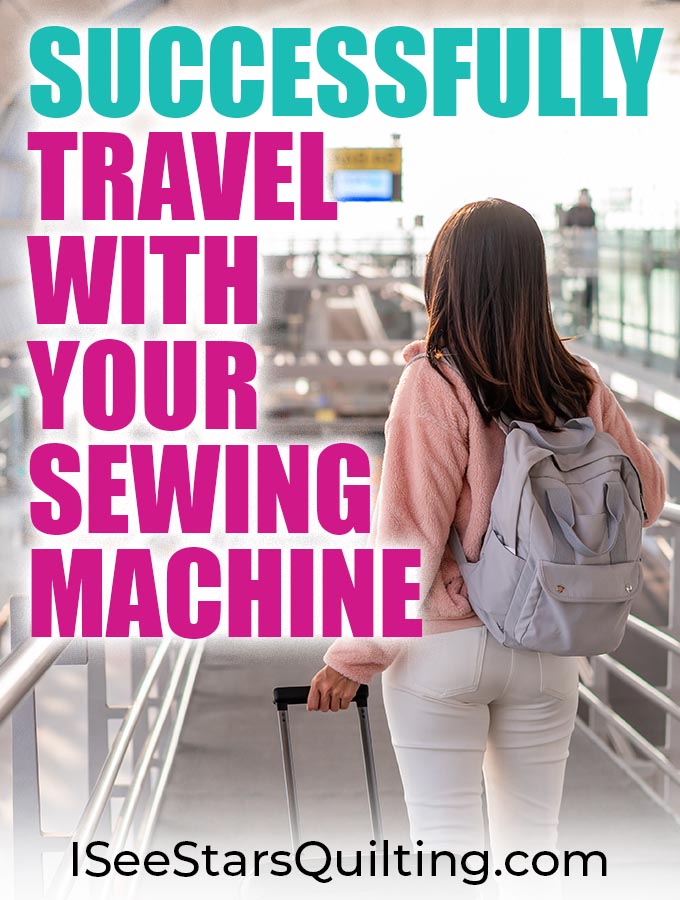
Tips for traveling through airport security
It is always wise to check the TSA website prior to traveling with anything unfamiliar just to lessen the stress and hassle while you’re standing in line and feeling the prying eyes of those behind you…. ugh… the stress!
Essentially, with my experience, I’ve discovered that small hand-sewing needles are fine to travel with in a sewing kit.
Scissors should be in your checked baggage unless they are shorter than 4 inches – embroidery scissors are ok.
If you do happen to need to travel by air with your machine, here are a few tips:
- Take the lightest machine you own (only because it’ll be easier for you to carry through the airport. Most airlines don’t weigh carry-on bags). You may be tempted to take your beautiful big sewing machine, but a trip through a large airport will take a lot of strength out of your sewing arms!
- Be patient as you travel. (Actually, that’s just a good rule in general.) It is easy to forget that your stressful day traveling is only really your problem. The TSA officers are just doing their jobs and sometimes they have different interpretations of what is or is not allowed. Also regulations change from time to time and while they may seem like they’re just being difficult… their number one priority should be to keep other travelers safe – no matter how non-threatening you look in your crocheted sweater!
- Your sewing machine is best stored as a carry-on item in the upper luggage compartment on the airplane. Look for someone who can help you lift it up there if you are unable.
- Check into a rolling cart or storage bag for your sewing machine. I like the ones down below.
Congratulations! Now that you have prepared and reviewed what is necessary to take your sewing machine on the road, you are set for an exciting adventure. Your diligent commitment to making sure it is safely packaged and ready for transport will give you peace of mind as you travel with confidence.
The satisfaction of knowing that all components of the packing process have been taken care of will allow you to enjoy every moment of your sewing retreat. Don’t forget to take some time for yourself to reflect and savor your creative processes. Remember, this journey isn’t just about results but about experiences too! Once again good luck in your journey, if ever in doubt look at this blog post as a reference guide along the way!
Also, leave a comment below if you have any other thoughts or suggestions….happy travels!

Traveling With A Sewing Machine (Tips & Best-Practice)
How can you best bring a sewing machine during travels? There is actually a lot to consider here.
Can you bring a sewing machine on an airplane? What are the best travel sewing machines What are the best travel cases and bags? How do you bring a sewing machine in a boat and an RV?
We will dive into all this and much more in this blog post!
[su_spacer]
Table of Contents

Before we look at the best sewing machines for traveling and the best the best bags and travel cases, we will look at how you can bring the sewing machine with you on an airplane. It’s pretty straightforward, but there are some things you need to know before you leave for the airport.
Let’s start out by looking at some of the most asked questions for traveling with a sewing machine.
Bringing a sewing machine on an airplane
You might be wondering if you are even allowed to bring a sewing machine on the airplane. It’s full of sharp and pointy objects and it could seem like that would be impossible.
[su_note note_color=”#e7ffcf”]Can I bring my sewing machine on an airplane? Yes. You can bring your sewing machine on the airplane, as long as you remove any sharp objects and prepare it carefully by having it in a travel bag that can fit as hand luggage. But there are precautions you need to make in order to be sure you can bring it through security. [/su_note]
According to the TSA website, you can bring a lot of sewing gear including the sewing machine itself during air travel. So we can check that box.
Now let’s look at what you need to do before you hit the airport.
Can I get the sewing machine through security?
Again, yes you totally can.
It will have to go in its own bin, and you should pack it separately from anything else you might bring on the plane. This is just to make it as easy and quick to get through security.
But be ready to get stopped in the waiting line and get inspected. They might not even open up the machine or anything, but when you carry a big heavy item you should expect them to pay a little special attention to you.
The only note regarding sewing machines are:
“ Yes , you can bring it as checked baggage or carry-on. You should check with the airline to ensure that the item will it in the overhead bin or underneath the seat of the airplane.” (Excerpt from the TSA website.)
So the next question is:
How do we go about it?
Let’s look at the things we need to consider and some security related precautions we need to take.
We will start by looking at where you will place your sewing machine on the place: As checked in baggage or as carry-on into the cabin?
Check-in luggage or as hand luggage?
Before you decide whether to bring it into the cabin or check it in you should think these things:
- How big is your machine? (will it fit in the overhead bin or below the seat)
- How heavy is your machine?
If it’s a normal size home sewing machine it should generally be no problem at all. You can totally bring these on the airplane, and you decide yourself if you will bring it with you into the cabin or leave it as checked baggage.
The main consideration is related to how well protected the sewing machine will be in the checked baggage area!
As soon as the checked baggage enters into the little cars and wagons to be transported to the airplane it may get several bumps. Also in the other end when the airport people will pick it up and transport it to the conveyer belt (baggage carousel) it may or may not fall down and get handles a little roughly.
So if you don’t have a good solid case for it I would definitely carry it with me into the cabin so you can make sure it’s not damaged or scratched in the process.
Can I bring sewing needles on an airplane? Yes, you can. According to the TSA, you can bring sewing needles. You can also bring a scissor as long as the blades are shorter than 4 inches from the pivot point.
You are actually allowed to bring these things in your carry-on :
- Needles for sewing, knitting, and crocheting
- Scissors that are shorter than 4 inches from the pivot point
- Safety pins
- Nail clipper
- Multi-tools (without blades)
These items are not allowed in the carry-on: Razor-type blades, Scissors which are longer than 4 inches from the pivot point and box cutters.
There is actually a pretty funny Instagram profile made by the TSA with a ton of pictures of what people try to bring on the plane. Very funny!!
The guys at TSA are not without humor. I scrolled through the full list (alphabetically) of what you can bring and cannot bring on the airplane, and I got to the letter “L”. Here I found “lightsabers” among the other items on the list. You know the ones from Star Wars.
And the instructions regarding these are:
Sadly, the technology doesn’t currently exist to create a real lightsaber. However, you can pack a toy lightsaber in your carry-on or checked bag. May the force be with you.
So cool, and sweet to find a little humor a serious site like this 🙂

You need to do this before arriving at the airport
Whether you want to bring the sewing machine as carry-on or you will check it in you should do a few things before you enter the airport:
- Remove the needles . Not because you cannot bring it on the plane (because you can), but because it can fall out during transportation.
- Remove the presser foot and bobbin as well (just to be sure)
- Remove the spool on the spindle.
- Tape down any other moving parts (or remove if you can).
Finally, you need to make sure it’s well protected from wind, weather, and bumps. So the best option here is a hard case trolley designed for your sewing machine. Then you can be absolutely sure it won’t get damaged, and it’s also the easiest way to carry it around the airport.
Remember you might have to walk a long distance to get to the gate, and a sewing machine is not exactly the type of item you want to be carrying around on a long distance.
So let’s take a look at these travel cases and bags.
Travel cases and bags
You need a good solid travel bag for your sewing machine if you travel a lot. Especially if you have to bring it on the train, bus, etc. You should always go for a model which is designed especially for your machine. That way you will be absolutely sure it fits well.
A soft dust-cover type of cover will not be a good option for traveling unless you just carry it in and out of the car. Then you will probably be just fine.
If the travel case or bag does not fit your machine exactly the machine will be able to move around. That’s not optimal. You need to make sure the machine is fastened and secured inside the travel case.
[su_note note_color=”#e7ffcf”]Over at SewingMachinesPlus they have made it really easy to find the right travel bag or case for your machine. Just choose which style of bag you are looking for and then choose the brand of your sewing machine. Check it out here . [/su_note]
The best bag will always be a hard case bag. They come in a lot of different designs and styles.
If you travel to class regularly or you are a real travel bug, you should definitely get a hard case. That would be our advice. It’s also a good idea for your wishlist at christmas ? 🙂
A lot of people bring their sewing machine on their boat.
Why not bring your hobby along when you are going on a longer trip? Maybe you are going away on a big boat where you can do projects along the way or maybe you just want to be able to fix stuff along the way like curtains, sail etc.
Let’s take a look at how you can do it and what you should consider before leaving.
How to power the sewing machine on the boat?
Powering household machines and other electrical items on a boat takes a little planning beforehand. You want to think about things like:
- Can our generator or power source generate enough power?
- How many watts, volts and amperes does the machine need ?
- Will I have enough space?
We have listed some light-weight and portable sewing machines below. These are good for smaller projects on the way, but if you want to be able to sew boat canvas, vinyl, sails and other heavy duty fabric you might find on a boat you need a heavy duty machine.
[su_service title=”Good heavy duty machine” icon=”icon: hand-pointer-o”]The best sewing machine for a boat is a light-weight heavy duty machine. We always recommend the Singer 4411 Heavy Duty for that kind of stuff. That would be a great machine to have onboard if you want to be able to fix the fabric of a sail, tarps, covers upholstery work etc.[/su_service]
Sewing in an RV
Just like boaters a lot of RVers love to bring their sewing machine in the RV.
Maybe you want to be able to relax with a sewing project during the trip or maybe you want to bring it to fix the curtains or doing some upholstery work.
Here you also need to make sure your generator can generate enough watts for a sewing machine .
The short answer is that you can easily power your sewing machine from the generator or whatever power source you might have in the RV.
It only pulls like 85 watts, so that will work just fine.
THen you need to have space for it. Obviously, space is a big issue when you move your life on the road in an RV. There are small portable and light-weight models you can buy for cheap. Those are a great option for sewing during travels.
Let’s take a look at some good portable machines you can bring on the boat, the RV, or just during travel in general.
Best light sewing travel sewing machines
If space is tight or you just want a small and portable sewing machine there are many great options you can go with.
Over at Amazon, they have a whole section with small sewing machines and you find the best brands like Singer, Brother, Janome etc.
Singer 1304 (SUPER light!)
We recommend this Singer 1304 model (link to Amazon) . It only cost around $80, and you get a high-quality machine that only weighs 7 pounds !
It has more than 700 reviews and a rating over 4/5 stars! So people are happy with this bad boy and it even has some cool features (like to standard sewing machines) like:
- 6 different stitches
- Weighs only 7 pounds(!)
- Automatic bobbin winding mechanism (stops when the bobbin is full)
- Dimensions: 13 x 7 x 11,5 inches
- can do buttonholes (4 steps)
- 2 presser feet
- Bobbin Winder
- Two spool pins
- Removable storage compartment with space for extra bobbins, needles, etc.
- See all specs here…
Brother CS6000i (Our recommendation!)
If you prefer Brother machines the CS6000i is a good choice. It’s also very durable and it’s compact as well.
It has over 7,000 reviews! and an average of 4,5/5 stars. So it’s the highest and most rated machine of the three we recommend in this article. It’s very rich on features but it also costs a bit more than the other two options. You can get it at $130 here at Amazon .
We recommend this machine because it has everything you need basically so you don’t need to compromise on what type of project you can do on the road. Great for taking to class as well as bringing along during travels.
- 60 stitches (!)
- Weighs 13 pounds
- Dimensions: 16 x 6.7 x 11.4 inches (also pretty small!)
- 1-step buttonholes (7 styles)
- 9 presser feet
- Auto needle threader
- LCD display
- Great for quilting as well as sewing
- See all the specs here…
If you don’t like digital displays or you prefer Singer models you can read on. Otherwise , this is your model.
Singer 2259 (More features)
If you want a little more features and you want a Singer model ( many people will only use Singer models ) you should go with this model. But only if you do not like the Brother above, or if you cannot use a digital display.
We found the best price again at Amazon ($96).
It just has more stitches to choose from than the 1304 model (19!) and the feature list is pretty good for a machine under 100 bucks and this size. It also has over 800 reviews, and people are generally very happy with this model overall. It has an average rating of 4/5 stars.
Here are the specs:
- 19 different stitches!
- Weighs 13,6 pounds
- Automatic bobbin winding
- Dimensions: 15 x 6.2 x 12 inches (a little bigger than the Singer 1304).
- Can do buttonholes
- 4 presser feet
- Adjustable tension
- Removable storage compartment. Also with extra space for everything you need around the machine.
Other options
They also have some great sewing machines over at Wayfair. They have really good prices and they actually have a surprisingly good selection of small and light-weight models. See the light-weight machines at Wayfair here .
A travel size sewing machine is just a great option if you like to bring the machine along. It’s great to be able to carry it easily and you can also use it for kids and elderly who cannot move around with machines .
What to bring (good checklist for traveling)
Here’s a good packing list for when you need to bring your sewing gear along for the travel. We have focused on what you can carry easily and tried to avoid bringing more than the most essential stuff.
Besides the sewing machine itself you should bring:
- Measuring tape
- Extra bobbins
- Straight pins
- Travel iron (maybe a portable ironing mat as well)
- Seam ripper
These are all things you need to have permanently in your sewing bag. And you can probably do without much else when you are on the go. Happy travels – we hope you learned a thing or two!
Related questions
We have found two other questions people ask a lot in relation to traveling with your sewing or quilting machine. We have listed them here as short questions and answers and hope you find them helpful.
How to transport a sewing machine? You need to wrap it carefully or carry it inside a hard case trolley. Before you transport it you should remove all removable parts and fix the rest with tape. Make sure it will not get shakes or bumps during transportation.
The last question is a good question when it comes to traveling with your machine. Because you might have it standing on its side during travel – especially if you end up checking it in with your check-in baggage.
Can you store a sewing machine on its side? Yes, you can. But you need to prepare it first to avoid damage. Put the presser foot down and remove spools and bobbins. Remove the needle as well before storing the sewing machine.

How to Travel With Your Sewing Machine Full Guide of 2024
By: Author Mutasim Sweileh
Posted on Last updated: December 21, 2023
This site is supported by our readers. We may earn a commission, at no cost to you, if you purchase through links.
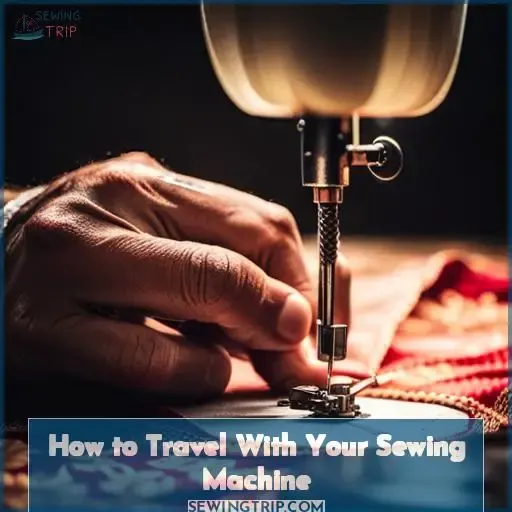
But before embarking on this liberating journey, it’s crucial to check airline regulations and restrictions that may vary for different providers. In this article, we’ll guide you through essential tips and tricks for traveling with your beloved sewing machine safely and hassle-free.
Table Of Contents
Key Takeaways
The container, travel-friendly sewing machine cases, packing essentials for sewing machine travel, airline regulations and restrictions, what to look for in a portable sewing machine, frequently asked questions (faqs).
- Select a durable container with protective padding for sewing machine travel .
- Prioritize organization with zippered compartments and open sections.
- Familiarize yourself with airline regulations and pack accordingly.
- Remove needles and secure accessories separately for compliance and safety.

When it comes to transporting your sewing machine , you want to ensure it’s well-protected and secure. Look for containers that offer durable protection against any bumps or jolts during travel.
Consider options such as fabric cases, art supply boxes, or even fishing tackle boxes—they are all excellent choices for keeping your sewing machine safe and sound.
Additionally, prioritize compact organization by selecting a container with zippered compartments and open sections for easy access to specific items like scissors, pins, and needles.
Don’t forget about style! There are plenty of stylish containers available that not only provide the necessary protection but also add a touch of flair to your travel ensemble.
And if you’re feeling crafty? DIY options allow you to customize both the security features and aesthetics of your container according to your preferences—truly giving you mastery over every aspect of packing a sewing machine for travel.
Sewing Machine Travel Bag Features
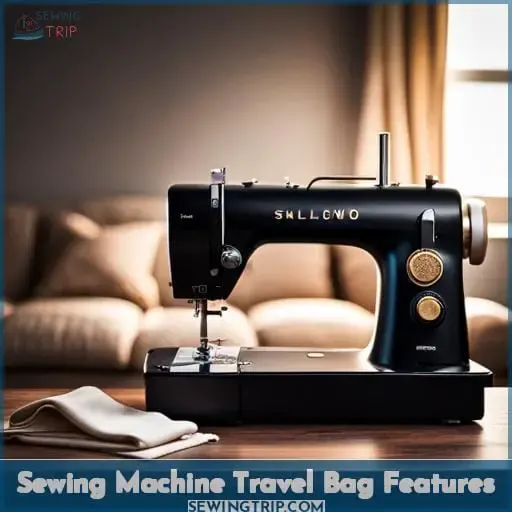
Look for features like sturdy construction, padded interior, and compartments for organizing accessories.
Additionally, don’t forget to pack the essentials such as extra bobbins and presser feet specific to your projects.
Lastly, familiarize yourself with airline regulations and restrictions regarding carrying sewing machines onboard or in checked baggage to avoid any surprises at the airport.
When traveling with your sewing machine, consider investing in a travel-friendly sewing machine case for added convenience and protection.
Look for durability factors to ensure the case can withstand the rigors of travel.
Compact designs are essential for easy transportation and storage.
Customization options allow you to organize your sewing supplies efficiently.
Security features such as locks or reinforced corners provide peace of mind during transit.
Don’t forget to check user reviews before making a purchase decision!
To ensure a smooth and hassle-free journey with your sewing machine, pack the essential items in a travel-friendly sewing machine case.
Look for cases that provide protective padding to keep your machine safe during transit.
Make sure there are secure compartments to store needle security and other attachments.
Opt for compact containers that meet airline regulations, so you can easily inquire about weight limits from your travel provider.
Prepare your machine beforehand by removing needles and securing them separately.
Before we dive into the features of a sewing machine travel bag, let’s address the airline regulations and restrictions that you need to be aware of when traveling with your sewing machine.
It’s important to ensure security compliance and follow travel-friendly cases guidelines. Be mindful of rules regarding needles and accessories, as well as proper machine preparation for safe transport.
Additionally, personal experiences can provide valuable insights into navigating airline regulations and packing tips for hassle-free travels with your beloved sewing machine.
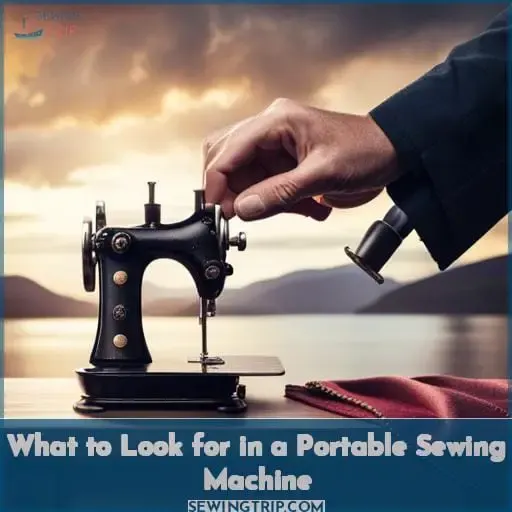
When choosing a portable sewing machine , there are several factors to consider that will ensure your freedom and mastery while on the go.
- Compact Options: Look for machines specifically designed with portability in mind. These machines are often lightweight and compact, making them easy to carry and store during your travels.
- Stitch Variety: Ensure that the portable sewing machine offers a variety of stitch options suitable for different projects. This versatility will allow you to tackle various types of fabrics and designs while maintaining creative control.
- Durability Factors: Consider the durability of the materials used in constructing the machine as well as its overall build quality. Opting for sturdy construction ensures longevity even when subjected to frequent transportation or handling.
By keeping these considerations in mind – compactness, stitch variety, durability – you can confidently choose a portable sewing machine that meets all your needs while providing liberation and power wherever you go!
Are there any specific regulations or restrictions for carrying sewing machines on airplanes?
Contact the airline to inquire about any regulations or restrictions for carrying sewing machines as carry-on items.
Be prepared to comply with guidelines regarding accessories and security procedures if inspected.
Consider options like protective cases to ease transport.
How should I prepare my sewing machine for travel?
Remove the needle and accessories to comply with guidelines.
Securely store sharp objects in checked luggage.
Consider protective cases or padding around the machine.
Verify carry-on size and weight restrictions.
Ensure proper preparation to ease transport worries.
What type of suitcase should I use to transport my sewing machine?
When transporting your sewing machine,
opt for a soft-sided carry-on suitcase that provides a snug yet flexible fit. This allows you to securely pad the machine while meeting airline size requirements.
Prioritize protection and portability to simplify your sewing travels.
How can I protect my sewing machine from damage during travel?
Carefully pad your machine inside a suitcase using quilts or soft materials.
Avoid shifting by securing it tightly.
Inspect for signs of damage whenever handling your luggage.
Travel safely knowing proper precautions prevent sewing machine harm.
What are some personal experiences or tips from others who have traveled with sewing machines?
When traveling, soft-sided suitcases allow flexibility fitting machines. Quilts pad nicely.
Expect inspections; anticipate answering questions.
With preparation, your machine will arrive safely to inspire creativity anywhere.
To ensure a hassle-free and liberating sewing experience while traveling, it’s important to carefully consider the container and bag you use to carry your sewing machine.
Look for travel-friendly sewing machine cases that provide adequate protection and storage space for your machine and essential accessories.
Familiarize yourself with airline regulations and restrictions to avoid any issues during your journey.
And when choosing a portable sewing machine, prioritize features that make it easy to transport and use on the go.
With these tips, you can confidently carry your sewing machine wherever you go. Happy sewing!
Related Posts

Kenmore Sewing Machines’ Rise and Fall: History of the Brand’s Most Popular Models (2024)

Is Slinky Material Stretchy? Your Guide to the Versatile Fabric (2024)

Difference Between Flannel and Chamois Shirts: Weight, Patterns, Cost (2024)
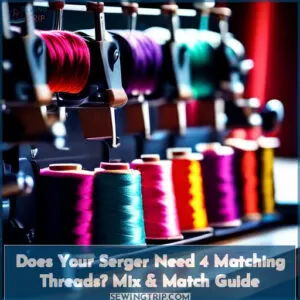
Does Your Serger Need 4 Matching Threads? Mix & Match Guide (2024)

How to Fix an Uneven Quilt: Expert Tips for Perfect Blocks & Borders (2024)
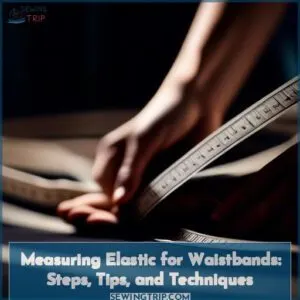
Measuring Elastic for Waistbands: Steps, Tips, and Techniques (2024)

- Type 2 Diabetes
- Heart Disease
- Digestive Health
- Multiple Sclerosis
- COVID-19 Vaccines
- Occupational Therapy
- Healthy Aging
- Health Insurance
- Public Health
- Patient Rights
- Caregivers & Loved Ones
- End of Life Concerns
- Health News
- Thyroid Test Analyzer
- Doctor Discussion Guides
- Hemoglobin A1c Test Analyzer
- Lipid Test Analyzer
- Complete Blood Count (CBC) Analyzer
- What to Buy
- Editorial Process
- Meet Our Medical Expert Board
Getting Through Airport Security With a CPAP
If you have sleep apnea treated with continuous positive airway pressure (CPAP), you may wonder how to get through airport security when you travel with your CPAP machine. It is important that you use your CPAP every night , even when away on business or vacation. With a few simple steps getting through security will be a breeze. Discover some helpful tips to travel with CPAP machines.
Travel Tips When Flying
First, do not check your CPAP machine as baggage. It is important that it not become damaged during transit, and the only way to ensure this is to keep it with you as a carry-on bag.
According to the Department of Transportation (DOT), medical devices such as CPAP are not counted as one of your carry-on or personal items, so you should not be worried about carrying it with you. It is still an extra bag to carry, so factor this into your plans as you want to be sure you will be able to carry it comfortably. It can be placed in the overhead bin or under the seat in front of you.
As you pass through the airport security checkpoint, you will likely need to remove the CPAP from its case, and it may be subject to examination, including a swab for explosives or X-ray screening. These are unlikely to harm the device. At some airports, the CPAP is required to be placed in a plastic bin for screening. Often it may remain in the bag and just be placed on the screening belt.
Most security screeners are likely to be familiar with CPAP machines and similar medical devices. However, if you are traveling to a part of the world that may be less familiar with them, you may wish to carry a letter from your healthcare provider briefly explaining its purpose and your medical need. This is generally unnecessary.
Using CPAP While Away From Home
Once you arrive at your destination, you want to ensure that you can comfortably use your CPAP machine. There are a few other things to keep in mind while you are traveling:
- Extension cord : It may be helpful to bring an extension cord as outlets may not be near the bed, especially in older hotels.
- Distilled water : It is recommended that you continue to use distilled water in the humidifier, but tap water is safe in most regions. If you are uncertain, err on the side of caution.
- Power adapters : Modern CPAP machines have an internal voltage converter, but you may still require an outlet adapter if you are traveling abroad.
- Extra parts : Depending on the length of your trip, you may want to have an extra supply of essential components, including your mask, tubing, and filters. If a last-minute replacement is needed, you may want to have the phone number for your equipment provider.
These travel tips will allow a quick passage through security and a healthy and restful trip wherever your journey takes you. If you have any further questions or concerns, speak with your sleep doctor for additional advice. Don't leave your CPAP at home. You will want to rest just as well on your trip, and it is possible to travel with your CPAP with ease.
Frequently Asked Questions
When flying with a CPAP machine, you should bring it as a carry-on. Do not check your CPAP machine with your luggage as it may become lost or damaged during transit.
No. You can carry your CPAP machine onto a plane, but it will not count as one of your carry-on or personal items. Medical devices, like a CPAP machine, are allowed to be brought onto planes as an extra item and can be stored in the overhead compartment or under the seat in front of you.
Before packing your CPAP machine for air travel, you should remove the water if you use a humidifier. It is also a good idea to clean the machine before packing it up.
When traveling with a CPAP machine, it is a good idea to pack backup parts and supplies, including your mask, tubing, and filters. In addition, bring extra batteries, a power adapter, and an extension cord.
If you use a humidifier with your CPAP, you may want to bring distilled water or purchase distilled water after you land. If you bring the water through airport security, they will open and test it for explosives.
You may also want to include a letter from your doctor or a copy of your prescription for the CPAP machine, but in most cases, you won’t need to show it.
Batool-anwar S, Goodwin JL, Kushida CA, et al. Impact of continuous positive airway pressure (CPAP) on quality of life in patients with obstructive sleep apnea (OSA) . J Sleep Res . 2016;25(6):731-738. doi:10.1111/jsr.12430
Schnirman R, Nur N, Bonitati A, Carino G. A case of legionella pneumonia caused by home use of continuous positive airway pressure . SAGE Open Med Case Rep . 2017;5:2050313X17744981. doi:10.1177/2050313X17744981
Department of Transportation. "Fact Sheet: Steps Taken to Ensure New Security Requirements Preserve and Respect the Civil Rights of People With Disabilities." Washington, D.C.
By Brandon Peters, MD Dr. Peters is a board-certified neurologist and sleep medicine specialist and is a fellow of the American Academy of Sleep Medicine.
My Favorites
- CPAP Machines
- CPAP Supplies
- CPAP Accessories
- Home Sleep Test
- What is Sleep Apnea?
- CPAP Therapy 101
- Best CPAP Machines
- Best CPAP Masks
- Best CPAP Cleaners
We’re here to help! Call 1.800.356.5221 Mon-Fri 8am-8pm CST Sat-Sun 8am-5pm CST
We’re here to help! Call 1.800.356.5221 M-F 8AM-8PM | Sa 8AM-5PM (CST)
- CPAP Therapy / Travel
Traveling and Flying With Your CPAP Machine in 2024: Top 10 Tips and Checklist
- Last Updated: Tuesday, February 20th, 2024
- Written By: Eric Ott
Table of Contents
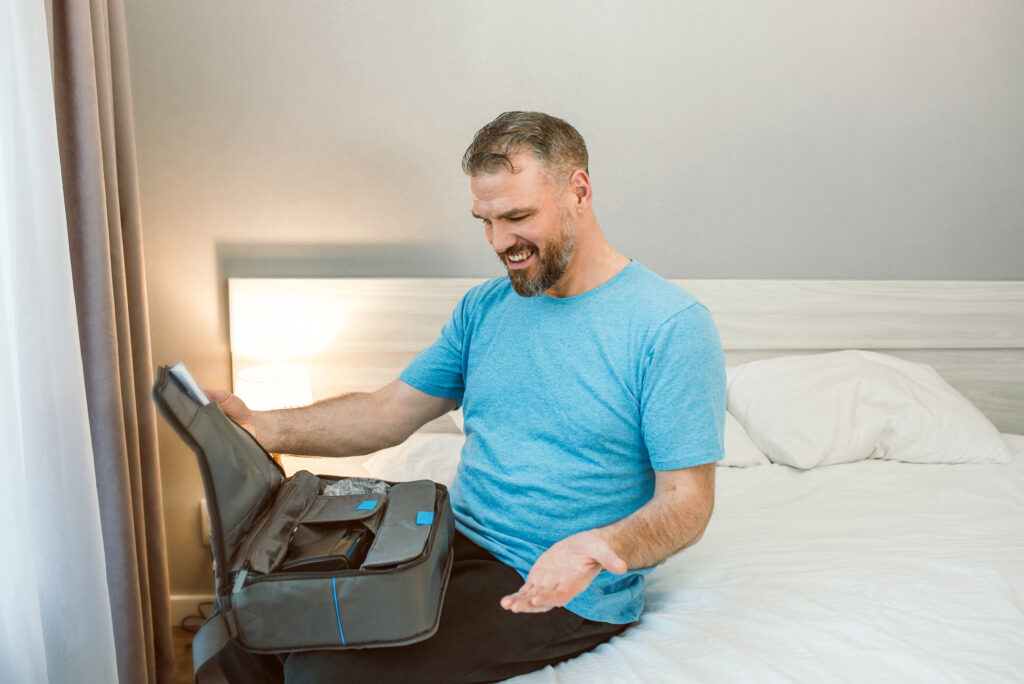
💡 Key Takeaways
- Before Traveling : Test and check your CPAP equipment two weeks before your trip. Bring extra supplies and a copy of your CPAP prescription.
- Flying Essentials : Your CPAP machine is not counted as carry-on luggage. Invest in a carrying case and bring distilled water if needed.
- Know Airline Policies : Contact your airline 48 hours in advance to understand their specific CPAP policies. Some may require a CPAP battery with a capacity longer than your flight time.
- TSA Tips : Use a clear plastic bag for your CPAP machine during security checks. Medical ID tags can expedite the process.
- Comfort Measures : Consider bringing a supportive neck pillow, a comfortable blanket, and easy cleaning methods like CPAP wipes for a more comfortable journey.
If you are someone who relies on a CPAP machine to get a good night’s sleep, the thought of travel can be a little daunting. The truth is, traveling with a CPAP machine is a lot easier than you think, and spending some extra time following the checklist and tips in this article will allow you to maintain your CPAP compliance and still get a great night’s sleep.
Whether you’re flying, taking an RV trip , or camping , with a little extra time and preparation, you can still enjoy the benefits of CPAP therapy while on the go.
In this article, we cover:
- 10 Tips for Traveling with CPAP
8 Tips for Flying with CPAP
- CPAP Policies for Popular US Airlines
- 3 Tips for Getting Through a TSA Checkpoint
- 7 Tips to Make Flying With CPAP More Comfortable
CPAP Travel Checklist: 10 Tips for Traveling with CPAP
Regardless of how you’ll be traveling, here are ten things you’ll want to do before ever leaving home with your CPAP machine:
- Test and Check Your Equipment in Advance – We recommend carefully inspecting your CPAP machine, mask, tubing, and any extra accessories (such as a backup power supply) two full weeks in advance of your trip. Search for signs of wear or any pieces that could break or fail during your trip. Doing this two weeks in advance will give you time to order any necessary replacements or backups, and will allow you to test any travel accessories, such as a new CPAP battery , in the comfort of your home.
- Replace Old Supplies – It’s a good idea to replace any worn CPAP supplies with new materials before your trip. Having a fresh tube, cushion, and air filter will make maintenance easier and reduce the chance of something important breaking while you’re away from home.
- Clean and Dry Before Packing – You’ll want to thoroughly clean your equipment immediately before packing it. Make sure that your equipment is totally dry to prevent mold and mildew from growing in your mask, tubing, or humidifier.
- Bring Extra CPAP Supplies – While packing a ton of extra supplies can get cumbersome quickly, we highly recommend designating some luggage space for a backup mask cushion , some machine filters , and/or an extra set of headgear . You never know when something might break, get chewed up by an in-law’s pet, or become lost, and having backup supplies will help to keep your therapy on track.
- Always Travel With a Copy of Your CPAP Prescription – While you’ll almost certainly never need it, you’ll be very glad you have it if the right (or more accurately, wrong) circumstances arise. You shouldn’t ever be asked to show your prescription, but you’ll likely need it in the event you have to order new parts or supplies during your trip.
- Pack Your Own Water – Distilled water is the only water that won’t calcify or cause mineral buildup in your CPAP machine. Relying on tap water for your CPAP machine’s humidifier is a bad idea and, depending on where you’re traveling, may not be healthy or feasible. We recommend traveling with your own supply of distilled CPAP water for peace of mind.
- Bring Easy Cleaning Methods With You – It isn’t always realistic to soak your supplies in a basin of hot soapy water, and CPAP wipes are a great alternative for your regular cleaning routine.
- Bring a Backup Power Source – A CPAP backup battery isn’t necessary most of the time, but if you’re traveling somewhere where there’s any uncertainty whatsoever about the stability or availability of electricity, you’ll still be able to maintain your therapy off the grid with an extra battery pack.
- DC Converters and Extension Cords Expand Your Options – A DC converter makes your therapy more versatile by allowing you to power your device with 12V DC outlets, some solar panel options, and even some CPAP backup batteries like the EXP48 and EXP96 Pro . By packing an extension cord, you’ll never have to worry about access to a nearby outlet or be unexpectedly constrained by the length of your tubing and power cord.
- Get a Medical Alert Wallet Card – A medical alert wallet card is a great idea even if you aren’t traveling, and could very easily save your life—especially if you’re traveling alone. By keeping a medical alert wallet card, first responders will be more informed about your health history and have a better idea of how to treat you in the event you become unresponsive.
If you’ll be traveling by air, the following section is just for you! Here are eight tips to make flying with your CPAP that much smoother:
- Check Your Luggage, Not Your CPAP – Your CPAP machine is a medical device and cannot legally be counted as carry-on luggage. Due to the sensitive nature of the machine, you should keep it with you at all times.
- Invest in a Carrying Case – Most modern CPAP machines come packaged in a machine-specific carrying case to make travel easier. If yours didn’t, we recommend using a separate bag to transport your CPAP machine since it won’t be counted as a carry-on. Even if it’s just an old duffle bag, you’ll be glad to have the extra room in your designated carry-on.
- Bring Distilled Water If You Need To – The TSA allows up to 3.4 oz of distilled water for carry-on luggage to accommodate those that wish to use their CPAP device in-flight. There’s no technical limit to how much distilled water you can bring in your checked bag, but the TSA does ask that you limit your liquids to “reasonable quantities”.
- Keep Copies of Important Documents Handy – Airline employees and TSA agents are trained to recognize medical devices and will not be surprised by your CPAP machine. While most modern CPAP machines are FAA-approved for in-flight use, having a copy of your manufacturer’s FAA-approval status will help to quickly clear any confusion that may (but most likely won’t) arise. Carrying a copy of your prescription can also be helpful if anything happens to your CPAP machine or equipment during the trip. Having your prescription on hand is invaluable if you need to replace some supplies or machine parts during your travels.
- Get Familiar With Your Flight Layout – TripAdvisor has a handy tool called Seat Guru that allows you to look up your flight’s floorplan in advance. This can be helpful if you’re planning to use your machine in-flight and require a powered outlet or simply prefer to know which seats have the most legroom.
- Flying Internationally? Bring an Outlet Adapter – Most modern CPAP machines are dual-voltage and will automatically detect and adjust to higher-voltage outlets. You will need a country-specific adapter, however, and you’ll also need to make sure that your CPAP machine’s power supply is rated for at least 220v.
- Call Your Airline 48 Hours in Advance – No domestic flight can deny your CPAP machine, but it’s always a good idea to be familiar with your airline’s policies about in-flight usage. We have a list of some of the more common policies below, but we recommend contacting the airline 48 hours in advance to make sure your trip goes smoothly. Please Note: Some airlines will require you to have a CPAP battery with a capacity longer than your flight time if you plan to use your machine during the flight.
- Don’t Forget About Waterless Humidification – If traveling with distilled water is not feasible for you, some travel CPAP machines , such as the ResMed AirMini and HDM Z2 , offer waterless humidification options that can help you save space and travel lighter.
Airline Requirements for CPAP Machines
Here are the CPAP policies of various airlines in the United States and a link to each airline’s policy overview. If you can’t find answers online pertaining to your specific airline, equipment, or needs, don’t hesitate to reach out to the airline’s help desk, as they will have the most up-to-date information:
- United – You will need to give at least 48-hour notice to the airline’s Accessibility Desk if you’re planning to use your CPAP on the airplane. To expedite this process, have the manufacturer information on hand, so United can verify it meets the FAA approval standards. You’ll also need to have enough portable batteries to power the device for the duration of the flight time plus 3 hours if you plan to use the device in-flight.
- Delta – Delta has a list of approved CPAP devices listed on their website that can be used without medical approval. Those planning to use the machine in-flight will need a battery with a capacity that is at least 150% that of the given flight time.
- American Airlines – American Airlines doesn’t require any sort of advanced notice if you plan to travel with or use your CPAP machine in flight. They do note, however, that passengers should not rely on the availability of powered outlets and may even need a DC power adaptor to utilize seat power aboard the aircraft.
- Jet Blue – You can use CPAP machines on Jet Blue flights, so long as they meet all TSA and FAA regulations (e.g., packing it away during landing, etc.).
- Southwest – Southwest encourages you to carry on your CPAP device to keep it protected during transit. You can use it on the flight so long as you meet all TSA and FAA standards. Per Southwest’s website, “Southwest Airlines does not have electrical outlets onboard the aircraft for commercial product use,” so like most others, be prepared to bring your own power supply if you plan to use your device in-flight.
All US airlines will allow you to use your CPAP machine during flight because it is a medical device. You should call the airline at least 48 hours in advance and ask for their official policies if you’re flying internationally.
3 Tips for Taking a CPAP Machine Through a TSA Checkpoint
Getting a CPAP machine through airport security may seem like a hassle, but TSA agents are very familiar with medical devices and know what to look for and expect. Here are some tips to keep in mind to expedite the screening process:
- Use a Clear Plastic Bag – You’ll have to remove your machine from its carrying case for screening, but you can pack your device inside a clear plastic bag to prevent unwanted germs or residues from collecting on your equipment during handling. Other accessories may remain in the case while the machine is screened.
- Request New Gloves if You’d Like – Sometimes, a TSA agent may want to perform an explosive residue test on your device. Using a cotton swab, the TSA agent will check your device for traces of explosive residue. While they will have to remove your machine from its clear plastic bag to do so, you can request for the agent to replace their gloves with new ones, a new cotton swab, or even a new plastic bag for your machine afterward.
- Medical Device ID Tags Help – TSA agents are trained to recognize medical equipment, but having a medical ID luggage tag (available at checkout) with relevant, easily identifiable information can reduce the amount of time you spend getting through your security checkpoint. It will also increase the chances of your machine being returned to you should it become lost at any time during your trip.
7 Tips To Make Flying With Your CPAP More Comfortable
It’s not uncommon for some people to have anxiety around flying in and of itself, regardless of whether you’re traveling with medical equipment. Here are a few optional extras to consider to make your flight that much more comfortable:
- A Supportive Neck Pillow – It’s almost cliche at this point to bring a neck pillow on the plane with you, but there’s a reason for that—it’s pretty darn comfortable. It’s also extremely helpful in keeping the spine aligned while sleeping in a seated position.
- A Comfortable Blanket – Alongside a good neck pillow, we recommend traveling with a blanket to keep you cozy during the flight. A weighted blanket can be cumbersome to travel with, but has actually been shown to reduce anxiety if you’re an anxious flyer.
- Aromatherapy Items – Whether you simply add some lavender essential oil to your neck pillow or want to add aromatherapy to your CPAP routine , scents can be very powerful for relaxation.
- Bath Accessories – While these won’t help you during the flight, they will certainly help you unwind after a long day of travel. Bring some bath bombs, lotion, and other self-care items to give yourself something to look forward to after the flight!
- Reading Material – Keeping the mind stimulated and occupied is an excellent way to pass the time if the in-flight entertainment isn’t cutting it for you. Paired with some earplugs, sinking into a good book can give a worried mind something else to focus on for a few hours.
- A Good Pair of Headphones – There aren’t enough good things that can be said about keeping a quality pair of headphones on you while traveling. Whether they’re noise-canceling or not, listening to your favorite podcast or music can help travel times pass more quickly, and SleepPhones are a niche solution that can help you nap and listen to music at the same time!
- A Portable Battery Bank – If you plan to entertain yourself with an electronic device or two during a long flight or day of travel, a portable lithium-ion battery bank specifically for recharging your phone, tablet, e-reader, or other electronic devices is a must-have. You’ll be glad to have it if your flight has a layover and it can be extremely helpful in the event of unexpected delays, too.
Frequently Asked Questions About Flying and Traveling With CPAP
Can i bring my cpap on a plane.
Yes, you can bring your CPAP (Continuous Positive Airway Pressure) machine on a plane. In fact, you should bring your CPAP machine in its own carrying case, as CPAP machines cannot legally be counted against your carry-on bag total, meaning you can still bring a carry-on in addition to your CPAP machine.
Does My CPAP Machine Count as a Carry-On?
No, a CPAP machine cannot be counted as a carry-on. Because of its status as a medical device, domestic flights (in the U.S.) are not legally allowed to count your CPAP machine against your carry-on bag total, and you’re encouraged to board with your device rather than check it in with your luggage.
How Should I Pack My CPAP Machine for Travel?
It’s best to pack your CPAP machine in a sturdy, protective case. Many manufacturers make CPAP carrying cases for this purpose. Make sure to bring all essential components, including the machine, hoses, mask, and power cords, plus backup supplies and cleaning necessities. Make sure you can access the machine itself so that you can have it readily available at security.
Can I Use My CPAP Machine on an Airplane?
Most modern CPAP machines are approved for in-flight use, but this can still be a difficult process. Start with getting a note from your doctor about your need to use a CPAP machine. Alternatively, your machine’s manufacturer should have a clause in the manual or on their website regarding your ability to use the device in-flight should you need to refer to it. Next, inform the airline that you will need to use your CPAP machine during the flight, preferably at least 48 hours before your flight. We also suggest checking the FAA website to ensure that your CPAP machine is approved for use on the plane. Last, bring an alternative power source! Most airplane seats don’t offer standard outlets, so it’s important to have a backup option if an outlet is not available on your flight.
Final Thoughts
When armed with the proper knowledge, traveling with a CPAP machine doesn’t have to be scary. It’s easy to have a smooth experience from beginning to end when you know what to expect ahead of time and pack accordingly.
Remember to pack everything you reasonably can to support a normal bedtime routine and sleep schedule, check with your airline 48 hours before your flight if you’re uncertain of anything, and don’t skimp on creature comforts if you get anxious flying. Do everything you can to prepare yourself and your equipment for the trip, and you shouldn’t face any insurmountable issues.
Of course, life happens, and we can’t always prepare for everything. Still, we hope the tips and information in this article will be of use to you the next time you plan on traveling with your CPAP machine!

Eric has been writing for the CPAP.com blog since 2021, where he combines his passion for understanding the nuances of complicated topics with a commitment to educating individuals diagnosed with sleep apnea. With thorough research, empathy, and product knowledge, he empowers readers to confidently navigate the world of CPAP therapy and reclaim the restful sleep they need to protect their health and live their lives to the fullest.
Need Help With Sleep Apnea?
11 Responses
Is there a travel machine suitable for those of us who use a VPAP or ASV machine? And does standard APAP help a person get by if he or she normally uses VPAP?
I am still under contract with my insurance company so if I purchase a mini will it synchronizes with my machine at home? Thanks Lyle Norton
I don’t believe that the machine would pair with your home machine via Bluetooth. Both machines would work independently of one another, and both would be able to share information with your care team, but they wouldn’t talk to one another. If you get a travel machine or any CPAP machine, the pressure settings would be set before it gets delivered to you. This is true whether you buy from CPAP.com or your insurance company.
Can you give me any information about battery pacs such as how much do they cost and how long do they last or stay charged. Thanks, Lyle Norton
Stay tuned! We’re going to be publishing an article on batteries next week, which will provide more info about that exact topic! In the meantime, I strongly encourage you to call us at 1-800-356-5221. Our customer service team is a group of trained CPAP experts who can help you find the exact battery info you’re looking for. They’re a great resource and have lots of valuable information to share.
I do a lot of traveling. I like taking my humidifier with me. Is there a hard case travel bag that works well with a Phillips dreamstation? The ones I find do not provide a spot for the humidifier.
Hey Larry, I have searched for a hard travel case that will hold your Dreamstation machine and Humidifier, but unfortunately, wasn’t able to locate one. My apologies.
Please let us know if there is anything else we can assist you in finding. We can be reached at: 1-800-356-5221, or via e-mail: [email protected] .
Enjoy your day!
Taking a trip to Bangkok a few months. Never have had to use my C-pap on plane. Does this mean they will sit me next to window. Don’t know the location of outlet on plane. I hope I don’t have to sit beside someone. I just don’t want them to fill uncomfortable with someone using a c-pap machine.
Hi Carl, Please speak with the individual airline regarding their policy and procedure for in flight use of your CPAP machine.
For other questions, or concerns, please feel free to reach us at: 1-800-356-5221.
Have a safe trip!
Can my husband’s cpap travel machine with battery can get into the plane with him or do we have to check it?? Thanks
hi, I am flying on frontier today and at the bag drop off found out that they do not allow Resmed CPAP machines to fly.
Leave a Reply Cancel reply
Your email address will not be published. Required fields are marked *
Need Help?
Need more help? Contact us!
Get help from an expert like Liz
Our experts know CPAP inside and out. Give us a call today and one of our 5 star customer service representatives will help you.
or Text "Help" to 832-308-2219
Call 1.800.356.5221
or Text "Help" to 832-408-9760
Mon-Fri 8am-8pm CST, Sat-Sun 8am-5pm CST
How to Travel with Your Sewing Machine? 7 Important Tips
If you’re a seamstress, there’s a good chance that your sewing machine is an important part of your life. Whether you use it for personal projects or as part of your job, the thought of being away from home without it can be stressful and even more so if you’re traveling.
Luckily, many airlines have improved their policies to allow passengers to carry on sewing machines if they meet certain requirements. Plus, there are plenty of other things to consider when picking up your machine and heading out on vacation (or even just visiting friends). In this article, we’ll cover everything you need to know about taking your trusty machine with you on the road!
Table of Contents
1. Carry-on Preferences
The first thing you’ll need to consider is the size of the carry-on luggage that you’re willing to carry.
- Check the dimensions of your machine, and make sure it will fit inside the bag without being too bulky or heavy.
- Consider what else you might want to take with you on your trip (a sewing kit? Fabric?) and how much space these items will take up in your bag.
- If possible, try out a few different bags at home so that you can get an idea of how big they are and whether this is something that works for your lifestyle. If these points still don’t make sense, fear not! We’ve got some real-life examples below that should help clear things up!
2. Weight Limits
If you’re traveling abroad, it’s important to be aware of the weight limits of your luggage.
The rules vary from country to country. Some countries require that travelers limit their total weight to 50 pounds, while others will allow you to bring up to 70 pounds of baggage on a flight.
As for airline restrictions, there are some carriers that require you to purchase an additional ticket for checked baggage if your trip exceeds 50 pounds. Other airlines will allow you to bring as much as 70 pounds on board with no additional charges.
To find out what weight requirements apply where you’re going, check with the relevant agency before booking your flight tickets or visit their website for more information.
Although, a general point of view according to my experience is
- Your carry-on luggage has a weight limit of 7kg (15.4lbs).
- Your checked luggage has a weight limit of 23kg (50lbs).
- Most sewing machine bags are designed to accommodate machines weighing between 20 and 25 lbs., so if you’re shipping or carrying your machine, make sure it doesn’t exceed 20 pounds when packed in its case. Some models have special features such as telescoping handles and wheels that will allow the bag to support up to 35lbs., but be aware that this type of additional construction will increase the cost of the unit by upwards of $100 USD.
- If you need something more heavy-duty than what’s standard, consider investing in a custom-built case with thicker walls and more reinforced stitching they’ll run anywhere from $300-$500 USD depending on how many features you’d like included in your design specs!
- The general rule is: don’t let any item weigh too much for its size if it looks like it might topple over while being moved around at an airport location (especially if there’s no one there helping out), then chances are pretty good that someone will come along soon enough anyway!
3. Insurance and Liability
Insurance is important for your sewing machine if you plan to travel with it. This is especially true if you have a vintage machine or one that was expensive, such as an industrial sewing machine.
While there are general guidelines for what types of insurance might be right for your situation, it’s best to consider all of the options before making a decision.
You’ll want to look into what type of insurance coverage would be best for your needs and how much coverage will cost (the price can vary widely).
It may also be helpful to know that some plans offer different kinds of protection; while most insurances cover theft or damage caused by accident, some policies include liability protection as well.
It’s important that you find out exactly what kind of coverage your policy covers and make sure it’s right for whatever situation arises during your travels!
4. Airline Comparisons
When it comes to finding the best deals, there are various ways you can do so. One is by comparing airlines and looking at their policies before attempting to fly with your sewing machine.
The first step in comparison shopping is to look up the airlines that service your destination and see what they have listed on their website.
Many of them offer checked baggage fees, while others don’t have any fees associated with checking luggage at all.
You should also be aware of any size requirements for carry-on items so that you’re not surprised when you arrive at the airport and find out that your bag won’t fit in an overhead bin or under a seat in coach class.
This will save you from paying extra fees or having to wait until after everyone’s boarded in order for someone else’s suitcase or garment bag to be removed from their compartment so yours can be put there instead!
5. Packing and bags
Now that you have all the supplies for your sewing machine, it’s time to pack.
- Use a bag that has wheels.
- Use a bag that was built to carry a sewing machine.
- Use a bag with hard bottom and top (this is important because if you put your sewing machine on the floor of an airplane or bus, severe damage can occur).
- Use a bag with a hard front as well as side panels on any bag that doesn’t already have them built-in (I use this same advice when packing suitcases for travel).
6. Security Checks
If your machine is in a hard case and you have the proper tools, it should be fine to check the sewing machine through. If not, then you’ll have to wrap it up in bubble wrap or something similar and check it as baggage.
Checking your machine as baggage may result in higher fees charged by the airline and/or additional fees charged by the TSA when they inspect your bag before boarding (if they don’t just charge you extra because they can). This can add up quickly if you’re paying out of pocket for each flight!
7. Sewing while Traveling
Sewing while traveling is not a difficult thing to do. It just needs some planning and preparation. If you choose the right machine and accessories, you can sew while traveling.
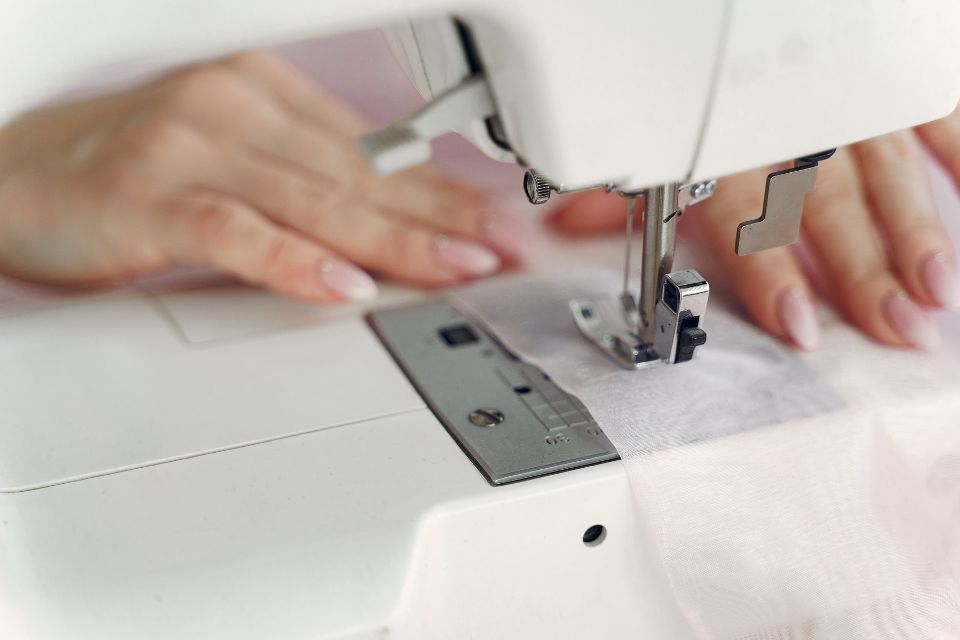
Here are some tips on how to do sewing while traveling:
1. Make sure you have a good quality sewing machine. You will need something that can handle heavy fabrics because it is going to be used for a long period of time.
2. Choose the right type of fabric for your project. The fabric should be lightweight but strong enough to last longer than other fabrics that are available at home or in the store.
3. Make sure that your sewing machine has an adjustable stitch length setting so that you can adjust it according to the type of fabric being sewn and also, make sure that it has a wide range of stitches, including decorative stitches such as satin stitch or zigzag stitch so that there won’t be any gaps between them when they are sewn together one by one on your project!
Can I Carry A Sewing Machine On A Plane?
You can carry a sewing machine on a plane. You can check it as luggage, carry it as a carry-on, or even have your sewing machine travel with you in the cabin on most airlines.
Some airlines allow you to buy an extra seat for your sewing machine (not recommended), while others will allow you to check it in its own case as part of your checked luggage allowance.
If there is no room for the box at the bottom of your suitcase, then take care not to overpack so that there’s enough space for both items.
Can I Carry A Sewing Machine On A Train?
The short answer is yes, but there are some important considerations to keep in mind before you pack up your sewing machine for a trip. Here’s what you need to know about how to carry a sewing machine on a train:
Will the train be full? The more people who are traveling with you, the harder it can be to find an empty seat. If it’s a busy day or night, your chances of finding an empty seat will be slimmer.
Is it heavy? How much weight your sewing machine weighs depends on its size and dimensions. If it’s made from metal or plastic, its weight may vary based on the thickness and composition of those materials (think of metals like aluminum, steel, or stainless steel).
What type of seat does the train have? Most trains offer seats that recline flat onto cushions if you’re able to get one of those seats. However, some trains don’t offer these seats so you’ll have to find another option if you want to put your sewing machine on a seat that reclines flat.
The next time you travel with your sewing machine, keep these tips in mind and enjoy!
- Keep it safe and secure.
- Pack it properly.
- Make sure it is insured (if possible).
- Make sure you can carry it on the plane.
- Make sure you can carry it on the train or bus or boat; whatever mode of transportation you are taking, make sure that your sewing machine will fit in the luggage compartments or under seats if necessary.
This article has been a helpful guide to understanding how to travel with your sewing machine. We hope it will be useful for those who have not done this before, or perhaps even help you rethink some of your current packing habits. As you can see from all the tips and tricks above, traveling with a sewing machine isn’t hard at all! All it takes is a little bit of planning and preparation before taking off on those epic adventures across this great big world of ours.
Related Posts

How to Shorten Yoga Pants by Hand in 2023? (Easy methods)
Add a comment.
Your email address will not be published. Required fields are marked *
Email Address: *
Save my name, email, and website in this browser for the next time I comment.

An official website of the United States government
Here’s how you know
Official websites use .gov A .gov website belongs to an official government organization in the United States.
Secure .gov websites use HTTPS A lock ( Lock A locked padlock ) or https:// means you’ve safely connected to the .gov website. Share sensitive information only on official, secure websites.
Am I allowed to carry my CPAP machine onboard the plane, do I have to remove it from my carry-on?
A nebulizer, CPAP, BiPAP and APAP must be removed from its carrying case and undergo X-ray screening. Facemasks and tubing may remain in the case. You may provide a clear plastic bag to place the device through the X-ray.

CPAP air travel: What you should know
CPAP air travel is more common than ever before. Because of the growing awareness of sleep apnea among doctors and the general public – not to mention the government officials responsible for regulating air travel restrictions – it’s never been easier to bring your CPAP machine with you while you fly. And it’s also possible to use your CPAP equipment during long flights.
CPAP air travel: What TSA has to say
Air travel with CPAP machines is allowed by the Transportation Security Administration (TSA), the agency that oversees the security for the U.S. travel industry. In fact, the TSA actively encourages sleep apnea patients to travel with their portable CPAP equipment .
“Our officers are very familiar with CPAP machines and see them numerous times daily,” the TSA blog team wrote in a 2011 article explaining CPAP air travel guidelines.
The TSA goes on to recommend bringing your CPAP machine on the plane as a carry-on. After all, if you check it, and your baggage is misplaced, “you’ll be without your machine.” The blog then explains how to carry your CPAP equipment onto a plane:
“So here is how it all goes down. The CPAP machine will need to come out of its case and be placed in a bin prior to being sent through the X-ray, but the facemask and tubing can remain in the case. We realize the X-ray bins aren’t exactly sterile, so if you like, you can place your CPAP machine in a clear plastic bag before you put it in the bin. After your CPAP machine is X-rayed, it may need to undergo an Explosive Trace Detection test where a small white swab will be run over your machine and then analyzed for trace amounts of explosives.”
Sounds pretty reasonable, right? Although it also sounds like it could take some extra time — so it’s probably a good idea to get to the airport even further in advance than the recommended two hours for domestic flights and three hours for international flights.
Also worth noting: ResMed CPAP devices are able to run on the 400Hz power supply found on aircrafts, and will not be negatively affected by the X-ray scanners at airport security.
This blog post contains general information about medical conditions and potential treatments. It is not medical advice. If you have any medical questions, please consult your doctor.

Related articles
Close Search
Transparency Disclosure — We may receive a referral fee for products purchased through the links on our site… Read More .
The 4 Best Travel CPAP Machines for 2024
Last Updated on January 24, 2024
Written by Sosha Lewis

Written by Sosha Lewis, Content Writer
Our testing process.
Here at Sleep Advisor, our Sleep Certified experts use a refined mattress and product testing process to give you unbiased product suggestions… Read our full product review process .
.st0{clip-path:url(#SVGID_00000046340743257271907690000000964648354283835324_);} In This Article
Are you looking for a travel CPAP machine? If you are we found four great choices for you.
Close to 40 million Americans 1 experience sleep apnea, a condition that causes you to stop breathing 2 for short periods while sleeping. Obstructive sleep apnea, the most common form, is often treated with continuous positive airway pressure (CPAP) machines, which use air pressure to prevent your airways from closing. 2
Those prescribed CPAP therapy should use their machine every time they sleep for the most effective results. However, this can be difficult when traveling because traditional CPAP machines can be cumbersome and difficult to pack. Fortunately, smaller, portable options are available so you can easily continue your CPAP treatment while on vacation or a work trip.
In this review, we will detail the best travel CPAP machines available so that you can select the one that suits your specific needs.
The Best Travel CPAP Machines for 2024
Resmed airmini – editor’s pick.
- Transcend Micro Auto CPAP Machine – Best Lightweight Travel CPAP Machine
- Breas Z2 Auto Travel CPAP Machine – Best Quiet Travel CPAP Machine
Apex XT Auto CPAP Machine – Best Budget Travel CPAP Machine
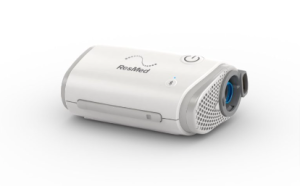
ResMed AirMini Portable CPAP Machine
This small and lightweight CPAP machine is an excellent choice for travel. It has a humidifier and a Smart Start and Stop feature that turns it on and off automatically.
Why the ResMed AirMini Earned Editor’s Pick
We were drawn to the ResMed AirMini’s small footprint, allowing it to fit in an overnight bag easily. Additionally, this model is FAA-approved for in-flight use, making it an excellent fit for frequent flyers (you will likely need to take documentation that states this with you on your flight, and you should check with your airline for any additional specifics).
The ResMed AirMini is also packed with worthwhile features such as AutoRamp, which allows users to start at a lower pressure and then increase to their prescribed one once they have fallen asleep. It will also automatically adjust your pressure based on your breathing. If your insurance company requires usage data, the AirMini app tracks your sleep data and detects mask leaks.
Our Take: A compact and lightweight travel CPAP machine, the ResMed AirMini packs many of the features found in bulkier at-home models.
What We Liked
- Compact design – The ResMed AirMini weighs 10 ounces and has a streamlined design. This makes it easier to travel with.
- FAA-approved – This device is FAA-approved, which means you can use it during flights.
- Waterless humidifier – The ResMed AirMini features a waterless humidifier. This convenience further adds to its appeal.
Potential Drawbacks
- Separate adapter – You must purchase a different adapter if you want to use masks and tubing that are not made by ResMed.
- Expensive – The ResMed AirMini has many features that make it a great choice for a travel CPAP machine, but it also comes at a pretty hefty price, which may not be ideal if your insurance isn’t helping with the cost.
Transcend Micro Auto-CPAP Machine – Best Lightweight Travel CPAP Machine
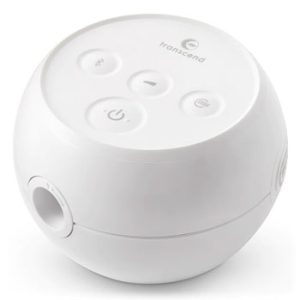
Transcend Micro Auto-CPAP Machine
Sleep advisor score, why the transcend micro earned best lightweight travel cpap machine.
Travel CPAP machines are more compact than standard models, making them easier to pack. While most of these devices don’t weigh much, the Transcend Micro is exceptionally lightweight, making it an excellent choice when you have limited space in your luggage.
Despite its tiny stature, it houses a lot of standout features such as auto-ramping and “drying mode,” a setting that decreases condensation that can lead to congestion. It will function up to 8,000 feet, so you should be able to use it during portions of flights.
Our Take: The Transcend Micro Auto-CPAP Machine is packed with features but weighs less than half a pound. It can easily fit in your carry-on or personal item bag, making it an excellent choice for travelers.
- Drying mode – This feature helps keep the tubing dry by preventing condensation buildup. This can help avoid congestion and keep your mask and hose clean.
- 30-day trial – The Transcend Micro Auto-CPAP comes with a 30-night trial so that you can see if it is right for you.
- Affordability – Although it is not inexpensive, it costs less than other comparable models.
- Noise level – The Transcend has a 31-decibel noise level, which is slightly above the recommended 30 decibels. A noise muffler kit is included, but that will be an additional component to pack and clean.
- Items not included – If you would like a portable battery or a waterless humidifier, you will need to purchase those items separately.
Breas Z2 Auto CPAP Machine – Best Quiet Travel CPAP Machine
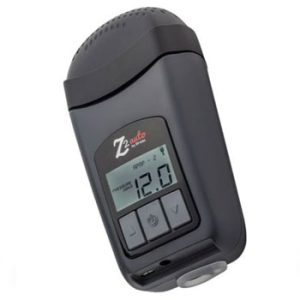
Breas Z2 Auto CPAP Machine
Why the breas z2 earned best quiet travel cpap machine.
Registering at only 26 decibels, the Breas Z2 is quieter than a whisper, making it a travel-friendly choice if you’re worried about making too much noise on the plane or if you’re sharing a hotel room. It is also smaller than most other travel models and won’t take up much room in your luggage.
Additionally, it is approved by the FAA for in-flight use, and we think it’s a great choice for campers because you can purchase a cordless PowerShell, which provides up to 8 hours of use without needing an electrical source.
The Breas Z2’s features include an automatic stop and start, auto-adjusting pressure, and ramping. The Breas Z2 also has an iOS- and Android-compatible app that allows you to access your sleep data easily.
Our Take: The Breas Z2 Auto is one of the quietest travel CPAP machines that we have found, making it a solid choice when you are traveling with others.
- Noise level – The Breas Z2 is one of the quietest travel CPAP machines on the market, making it a fantastic choice for when you’re traveling with others.
- Battery pack – For those going off the grid, the Breas Z2 has the PowerShell, a cordless battery pack that provides up to 8 hours of electricity-free use.
- Smartphone app – To ensure that you’re using your CPAP machine consistently, many insurance carriers require sleep data. The Breas Z2 can provide this information for you via an app for iOS and Android users.
- Accessories sold separately – The PowerShell and waterless humidification sensors are great accessories, but they cost extra.
- Auto start and stop feature – Many users will appreciate this feature, but we think that others may find it disconcerting.
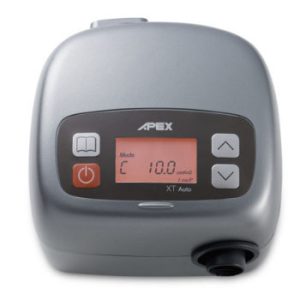
Apex XT Auto CPAP Machine
Why the apex xt earned best budget travel cpap machine.
Despite the convenience of travel CPAPs, you may find that your insurance won’t cover an additional device. Therefore, you may need to pay out of pocket. If you are looking for an affordable and reliable travel CPAP machine, we recommend the APEX XT Auto CPAP.
Additionally, this model may appeal to those who need to share sleep data with their insurance carrier, doctor, or the Department of Transportation (DOT), as it has “card-to-cloud,” a feature that records and stores your sleep data.
Our Take: The Apex XT Auto CPAP machine offers a consumer-friendly price point with many of the same features typically found in more expensive options.
- Simplicity – The Apex XT is a user-friendly model. It is more convenient to navigate and has a screen that makes it easier to read when it is dark.
- Sleep data card – The Apex XT comes with a card-to-cloud feature that tracks sleep patterns. This is great for those who need to log their sleep data as part of their CPAP treatment plan.
- Value – The Apex XT Auto is a solid travel-sized CPAP machine for its price point. If you want to get good value for your money, then we think you could really enjoy this item.
- Slightly more heavy – Although it’s still lightweight, the Apex XT weighs 1.6 pounds, which is more than many other travel CPAP machines.
- Parts sold separately – If you want a heated humidifier, it will be a separate purchase. Some people prefer this to come with their CPAP machine, so if that sounds like you, then you might be put off by the Apex XT.
What Is a Travel CPAP Machine?
Travel CPAP machines are smaller and more portable than typical at-home models. They have many of the same features as their full-size counterparts, such as masks, tubing, and air filters.
Travel CPAP machines usually have waterless humidifiers that make operating easier when you’re on the go. Furthermore, while portable CPAP machines can offer effective CPAP treatment, they are not intended for long-term, everyday use. Travel CPAP machines are convenient but often expensive; insurance doesn’t always cover them, and you may have to purchase separate accessories.
What to Look for in Travel CPAP Machine
Size & weight.
The size and weight of your travel CPAP machine are essential features to consider since you will want the device to be easily portable. Many travel CPAP machines weigh less than a pound and are only a few inches long. By being compact and lightweight, they are easier to pack and carry when traveling.
More: Best CPAP Mask for Women and Best CPAP Mask for Kids
Built-In Humidifier
In-home CPAP machines usually have a bulky water reservoir that makes them difficult to pack. Water chambers also mean that you will either have to pack distilled water or procure some once you have arrived at your destination.
Conversely, travel CPAP machines typically have a waterless humidification system that is also referred to as a heat and moisture exchange (HME). HMEs recycle the moisture from a sleeper’s exhalation into inhaled air. In some cases, the humidifier is sold separately, though, which is something you’ll want to check before purchasing a travel CPAP.
Noise Level
A low noise level is vital for all CPAP machines, especially for travel devices that you may use on crowded planes or in shared rooms. You’ll want to look for a travel CPAP machine with a sound level of 30 decibels or less. This level is considered whisper-quiet.
Pressure Range
You should have your travel CPAP machine calibrated according to your prescription. CPAP prescriptions usually call for pressure settings between 4 and 20 centimeters of water pressure. The majority of travel CPAP machines are equipped for these settings. If your pressure setting is above 20 centimeters, you’ll want to ensure your portable machine can handle that.
FAA-Approved
If your flight originates in the United States, you can carry on a CPAP machine, and if you pack your machine in its case, it doesn’t count as part of your carry-on luggage allowance. Fliers must empty their CPAP machine’s water chamber of all liquid. Large bottles of distilled water can be packed into checked luggage, and you can pack smaller bottles in your carry-on as long as they meet the carry-on liquids allowance of 3 fluid ounces.
To use your travel CPAP machine during your flight, you must provide Federal Aviation Administration documentation stating your specific machine is approved for in-flight use. You should check with your airline about any specific requirements regarding CPAP machine use during flights.
Travel CPAP machines can be expensive, with many portable CPAP devices ranging between $700 and $1,200. Insurance coverage depends on the carrier, but many will only cover one CPAP machine. Therefore, your insurance carrier may not cover a travel machine if you have an in-home unit. If this is the case, consider your budget and whether the amount you travel justifies the cost.
Parts & Accessories
Travel CPAP machines are typically smaller than standard models, but their design is similar enough that you’ll need many of the same accessories, including masks, air filters, and tubing. Some travel CPAP machines require specific accessories, or they may require an additional kit to ensure that they fit correctly. Additionally, portable CPAP machines have travel-specific accessories such as external batteries and waterless humidifiers, making them more convenient to use when you’re on the go.
Cleaning & Care
Cleaning and care instructions will likely vary by the manufacturer, and you will want to follow them to prevent any damage. As standard procedure, you will want to soak the tubing in warm water with a mild soap. After that, thoroughly rinse them with warm water and let them dry completely.
Most travel CPAP machines have a warranty. The specifics of the warranty will depend on the manufacturer, and you will want to be mindful of any actions that could void your warranty.
Other Travel CPAP Features
- Data tracker – Many insurance carriers require CPAP users to monitor their use to meet specific coverage requirements. Most travel CPAP machines have this feature, but you should double-check if you have insurance requirements.
- Pressure ramp – Pressure ramps allow users to start their CPAP therapy on a lower setting before gradually increasing to their prescribed amount. This may make it easier for users to fall asleep using a CPAP machine.
- Heated tubing – If your CPAP machine uses a humidifier, heated tubing can help prevent condensation from forming your tube.
Frequently Asked Questions About Travel CPAP Machines
Standard and travel CPAP machines can effectively treat obstructive sleep apnea. However, travel CPAPs are typically smaller and lighter than standard devices so that they can be easily packed for trips.
Many travel CPAP machines operate without a water tank, unlike at-home machines, which makes them more convenient and manageable. Travel CPAP machines should only be used for short periods, whereas standard models can be used for longer stretches.
Generally, you can only purchase a CPAP machine with a prescription from your doctor, and while you may want to take a copy of the prescription with you if you are flying, it usually isn’t an FAA requirement. However, if you plan to use your CPAP machine during a flight, ensure that you have the proper FAA documentation that states it is approved for in-flight use. You can usually find this on the manufacturer’s website.
Travel CPAP machine coverage will depend on your insurance plan and carrier. However, many insurance carriers only provide one CPAP machine. If you have a standard at-home CPAP machine that is covered by insurance, it may mean that they won’t cover a travel one.

Sosha Lewis
Content Writer
About Author
Sosha Lewis is a staff writer for Sleep Advisor. Lewis is happy that she is able to combine her love of sleep with her love of writing.
Combination Sleeper
- 1. Ling ND, Vanessa. “Sleep Apnea Statistics and Facts You Should Know”. National Council on Aging. 2024. –
- 2. “Sleep apnea”. Mayo Clinic. Last modified April 6, 2024. –
Traveling With Your Sleep Apnea Machine: Pros and Cons
Continuous positive airway pressure (CPAP) therapy is a leading treatment for sleep apnea and requires nightly adherence to prevent the symptoms of the disorder from returning.
However, it can be impractical to pack and take your sleep apnea machine when you go away, either for leisure or business. Fortunately, you can acquire a Travel CPAP, allowing you to stick with your sleep apnea treatment course when away from home.
What Is a Travel CPAP?

A “Travel CPAP” is lighter and smaller than a standard CPAP device, making it more portable for traveling. Being more compact, a Travel CPAP is also easier to pack. The machine should come with an integrated or stand-alone power option and support power outlets in the US and internationally.
A sleep apnea machine designed for travel has functions a standard machine does not in order to make using the device easier on the move. Most traveling machines will be FAA approved, which is key for sleeping on long haul flights.
It is important to consult your doctor or sleep specialist to ensure you purchase a Travel CPAP that provides the same benefits and relief from your sleep apnea symptoms as your standard device. This will include a pressure setting range specific to the severity of your sleep apnea.
The features to consider when choosing a Travel CPAP
Size is a primary reason for purchasing Travel CPAPs. They can vary in size, but you can pick up a CPAP machine for traveling similar in size to a smartphone. Different machines have different features, some built in, which results in the variation in sizes.
However, the key point is they should all be more compact then a standard machine. On top of that, devices designed for traveling are exceptionally light too and can weigh as little as 10 oz.
You must also take into account masks and any add-ons such as a humidifier when contemplating the overall luggage space a travel sleep apnea machine requires.
2. Battery Charge
If you are traveling somewhere a power source is not available, for example when camping, then how long a battery lasts is an essential consideration for adhering to your sleep apnea treatment.
Most of the popular travel devices have the option to be used with an extended battery.
A battery life for portable CPAPs tends to be between one and two days, although this can vary depending on the pressure settings required and whether you are using accessories such as a heated humidifier.
Most battery options are rechargeable, but this is not going to help you massively until you reach a power source.
Portable CPAPs are designed with features and options to help replicate some of the benefits of your standard machine when at home. These options include:
- ramp features so your machine can start at a lower pressure setting to help you fall asleep, before slowly increasing the pressure to the level required to keep the upper airways open while you sleep.
- accessories such as a heated humidifier, which is useful when traveling to drier climates, integrated batteries when power sources will not be available, and data tracking to help monitor the treatment and make changes if required.
You don’t want a noisy machine sat by you when trying to sleep, so the decibel level of any device is an important consideration. Today’s devices are much quieter than their predecessors, with the average device having a range between 20 and 30 decibels. To put this in perspective, 30 decibels equate with a whisper.
The Pros of Using a CPAP When Traveling
- Uninterrupted treatment – continued adherence to CPAP is crucial in preventing the return of your sleep apnea symptoms and continuing to reduce the risk of the health issues linked to the sleep disorder.
Travel CPAPs allow people to pack a more portable device when traveling, resisting the temptation to leave behind their device which otherwise may be deemed too bulky to pack.
- Quiet – as long as you ensure your traveling device is a more modern model with a range around 20 to 30 decibels, you can help ensure neither you nor your partner are disturbed by noise emitted by the device.
- Useful Displays – Some travel devices have integrated displays which make it easy to monitor and review treatment progress and to make any necessary adjustments.
While this may mean the device will be slightly larger than other models, it means you do not require a smartphone app to operate the settings.
- Slimmer Tubing – You can find devices which uses slimline tubing that takes up even less space in your luggage. While it will need an adjustment of the flow dynamics, another bonus from slimline tubing is it can make movement while asleep easier.
- Mask Options – Having a correctly fitting mask is key to the effectiveness of CPAP. With standard tubing you should still be able to use your preferred mask when traveling. However, you should check that your mask is compatible with any travel device before you buy.
The Cons of Using CPAP When Traveling
- Cost – Travel CPAPs are not particularly cheap and can cost between $450 to $1200. They are also less likely to be covered by health insurance. You may find devices that are cheaper, but the quality of the device is paramount as it needs to provide the benefits of your standard machine.
- No humidifier – Some devices come without a humidifier, which can be a problem if you suffer with dry mouth when using CPAP, or are traveling to a drier climate. So it’s important that a travel CPAP device has a built-in humidifier.
- Inconsistent pressure – Variations in pressure and algorithm responsiveness mean some devices don’t operate as well as standard machines. Closer attention may be needed to the settings, which should be altered by your sleep specialist if necessary.
Sleep apnea increases the risk of serious health issues like heart disease, stroke and diabetes. A sleep apnea machine that is portable for traveling ensures you can continue with your treatment when away from home.
https://www.sleepfoundation.org/best-cpap-machines/best-travel-cpap-machine#:~:text=When%20shopping%20for%20a%20travel,air%2C%20is%20FAA%2Dcompliant
https://www.verywellhealth.com/pros-cons-travel-cpap-sleep-apnea-4152026
Share This Story, Choose Your Platform!
About the author:.

Robert Koenigsberg
Founder and ceo, sleepquest, inc..
SleepQuest’s founder and CEO is a longtime sleep apnea sufferer and understands the physical and emotional hardship this disease can cause.
Robert has spent 30 years in the healthcare industry. In 1994, he had the vision to create SleepQuest’s care management program for patients with obstructive sleep apnea (OSA).
Robert is recognized as an industry expert. Various industry trade journals, healthcare research analysts and manufacturers of sleep diagnostics and treatment equipment have interviewed him extensively, using his expertise for reports on the Sleep Industry.
Related Posts

SleepQuest Announces New Walnut Creek Center!

The Long-Term Effects of Childhood Sleep Apnea

CGM for Diabetes and Effect on Sleep Apnea Control

How To Get Used To a CPAP Device

The Link Between Sleep Apnea and Neck Size

How to Overcome Nasal Congestion with Sleep Apnea

How Smoking Affects Sleep Apnea

Selecting a Pillow to Help with Sleep Apnea
Privacy overview.
Browser Security Check…

Monday - Friday : 09:00AM - 4:00PM
A FULL SERVICE TRAVEL AGENCY
Let Us Be Your Guide.
Lafayette's trusted travel agency since 1978.
Specializing in global, land, sea and air travel packages. We have been Acadiana’s one-stop shop for custom designed, service oriented trip planning for over 40 years.
Your destination awaits you.
Custom vacation packages.
KTDY 99.9 Cruise
Sail away for Mardi Gras 2023 with KTDY and CJ and friends. Ports of call will be Roatan, Costa Maya & Cozumel. Exclusive packages available through Travel Machine Only.
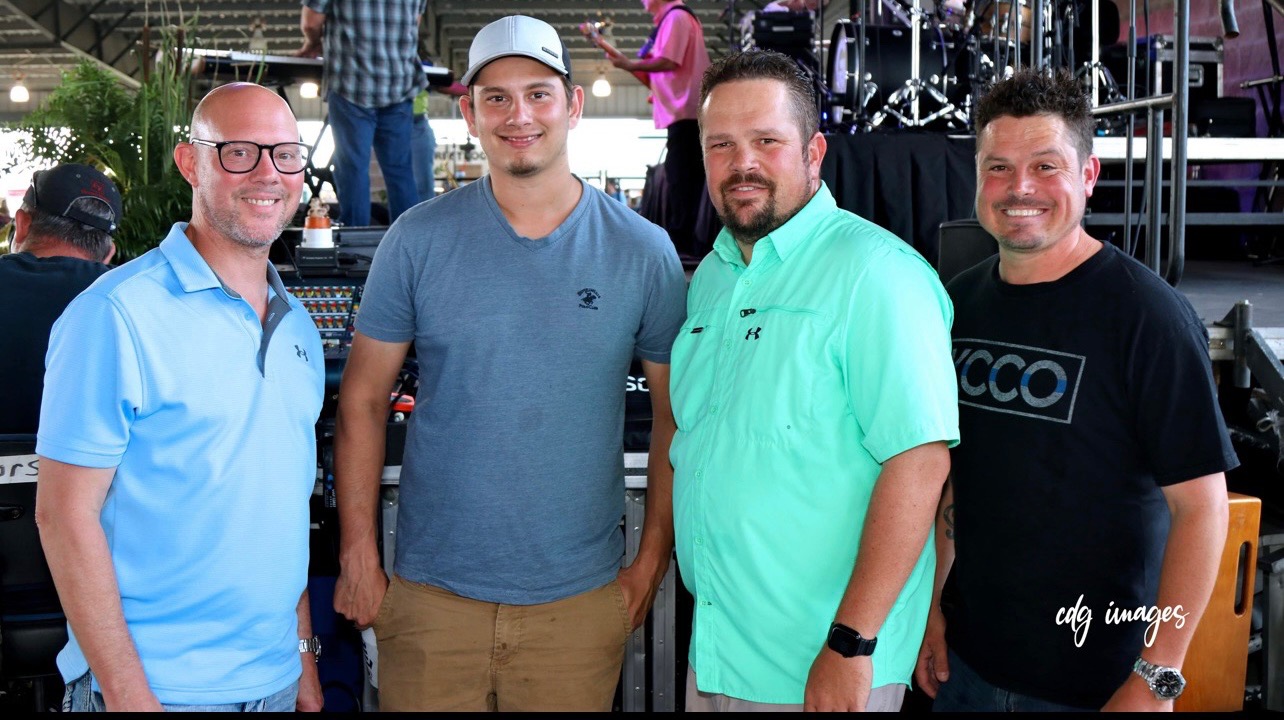
Ryan Foret & Foret Tradition
Celebrate in Cozumel with beautiful beaches, serene ocean water, and great music! Join Ray Foret as we sail the Caribbean on November 1st, 2023.
Adults Only Luxury Vacations
Whether you are searching for a honeymoon, a bachelor or bachelorette party, or a group vacation free of kids, our Travel Advisors can help you book the relaxing vacation you want.

Custom Tailored European Vacations
See the cliffs of Ireland, the mountains of Switzerland, the castles of Germany, or the Running of the Bulls. Our travel professionals will help you see the very best of Europe.
We’re here to help you
Plan Your Disney Vacation
Travel Machine is an Authorized Disney Vacation Planner. Our agents have over 20 combined years of experience with planning trips to the happiest place on Earth!
Domestic Travel We can book your flights, hotels, rental cars, entertainment, food, and more. Whether for business or pleasure, Travel Machine has your back, no passports required! Our agents can help you save time and money.

let us be your guide
Services & trip packages, honeymoons & destination weddings, group travel, all-inclusive travel, adults only travel, disney theme parks, corporate travel, honeymoon fund registry, dont take our word for it..., what our travelers say:.
FREQUENTLY ASKED QUESTIONS
Travel during covid-19.
When you hire a professional travel agent, you are getting more than just an itinerary. Travel professionals can give you the most up-to-date information on restrictions, bans, FAA guidelines, and answer your trip-specific questions to that you can travel with peace of mind.
According to CNN, Americans have the sixth most powerful passports in the world. Our visa-free access to nearly 200 countries and growing is part of the reason for the popularity of international travelers in the U.S. There are currently no official bans on American travelers that are specific to COVID-19, but there are countries that Americans are not allowed to visit. Check with your professional travel advisor for more details.
Everyone entering the U.S. must show a negative COVID-19 test to be allowed into the country, but what about other countries? Unfortunately, every destination has their own set of rules and regulations and you are subject, as a traveler, to local laws and ordinances and the burden is on you to know the rules. Contact a trusted travel agent to help you ensure a smooth trip.
March 13th marked the one year anniversary of the U.S. total ban (no-sail order) on cruises. The U.S. is not alone in this inconvenience, cruises have been halted throughout much of the world. As of publication, the ban on cruises will remain in effect until November of 2021. The best bet is to talk to a professional travel agent who can give you some options to book a cruise for 2022.
Proud Members of the Acadiana Business Community
Awards and accreditation.

Contact An Agent Today
NIK-L-BEER Party Cruise - March 3rd – March 10th, 2023 - Ports: Galveston – Cozumel, MX – Costa Maya – Roatan
Big 102.1 Big Holiday Sail Away - December 5th – December 9th, 2024 - Ports: Galveston, Cozumel
Front-Load vs. Top-Load Washers: Which Is Better?
Good Housekeeping Institute's cleaning pros set the record straight.

We've been independently researching and testing products for over 120 years. If you buy through our links, we may earn a commission. Learn more about our review process.
So you're in the market for a new washing machine. As any appliance is a major investment, you have a big decision to make — one made more complicated by the fact that you have to decide between two distinct types of washing machines: a front-load vs. a top-load washer.
At the Good Housekeeping Institute Home Care and Cleaning Lab, our product analysts and cleaning experts have been testing washing machines of all types for more than a century, assessing everything from cleaning performance to the machine’s gentleness, water and energy usage, specialty cycles and more. To help inform your next big purchase, we leaned on our pros' years of collective hands-on experience and extensive testing data to break down the major benefits and disadvantages of front-load and top-load washing machines.
Top-load washers, at a glance
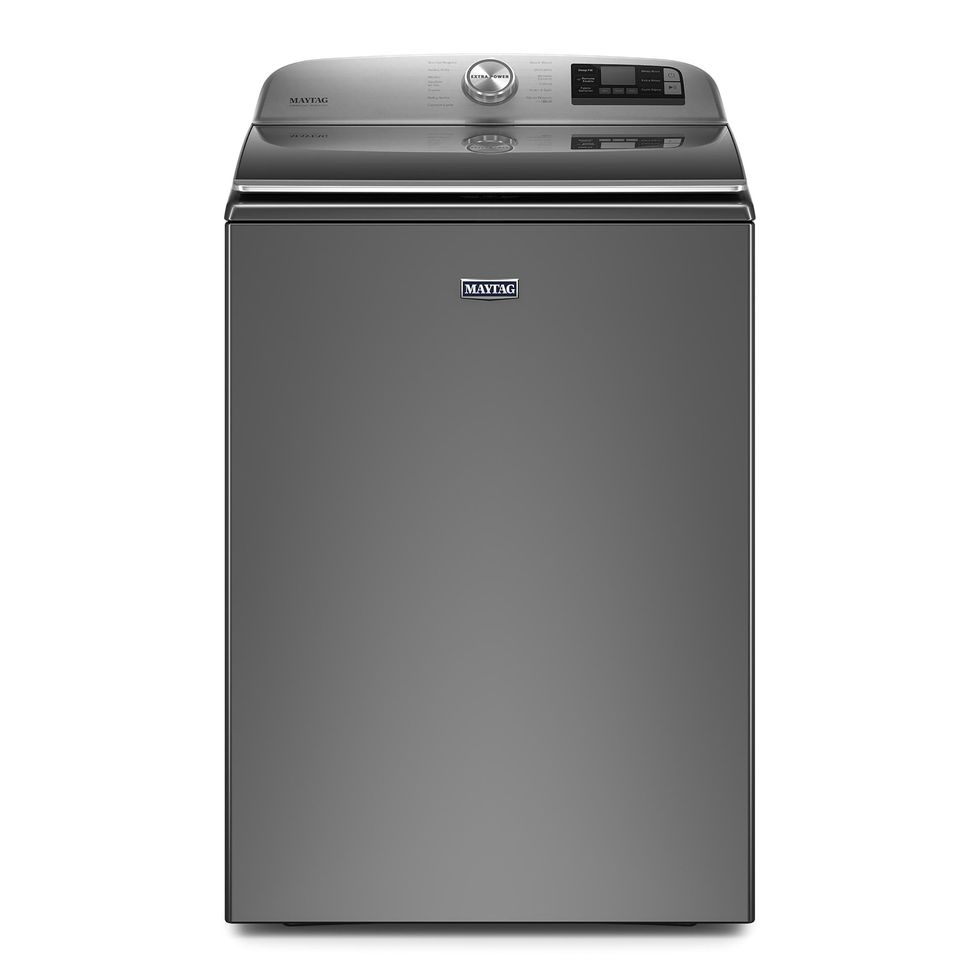
Maytag Top-Load 5.2 cu. ft. Capacity Agitator Washer
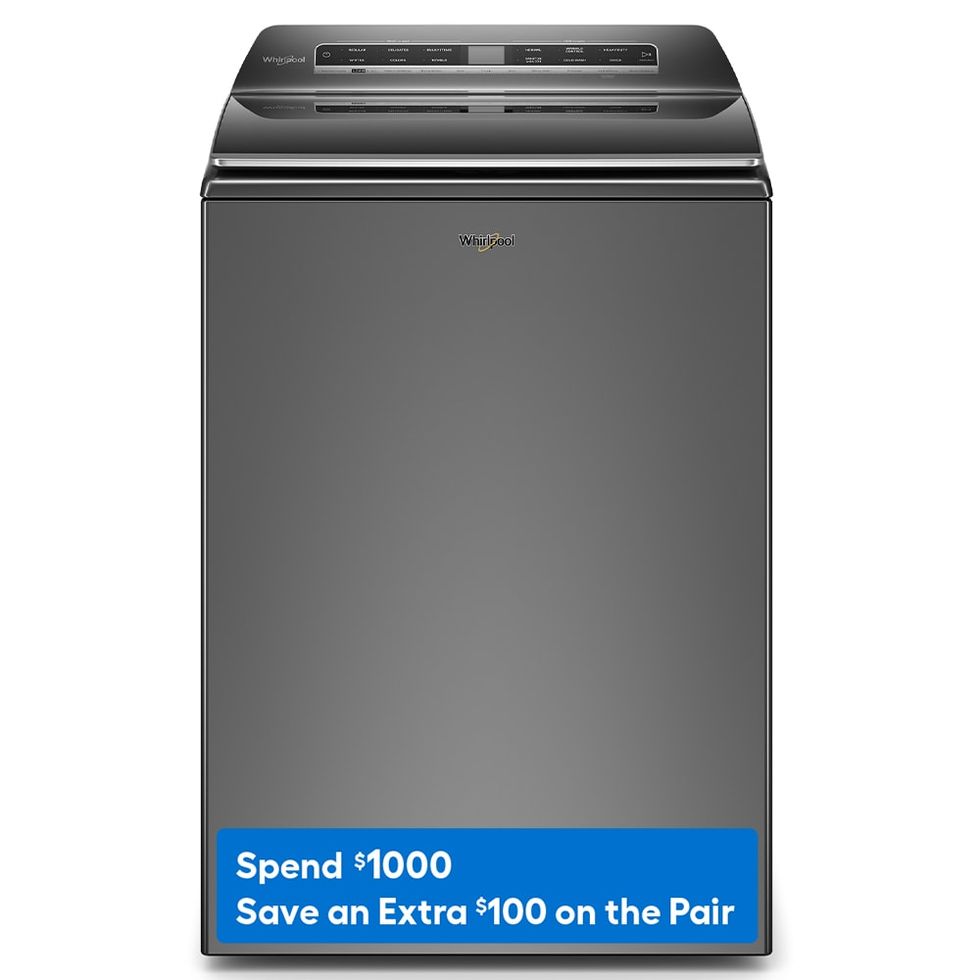
Whirlpool Top-Load Washer with 2-in-1 Removable Agitator
The more traditional of the two, a top-loader's drum sits vertically in the center of the machine. They may come with or without an agitator and bounce clothing under a water shower or swish items through water in the tub.
Pros of a top-load washer
- Requires less bending and is easier to load: A front-load washing machine requires the user to bend down to load and unload laundry. With a top-loader, you can stand while doing the laundry, leading to less back strain.
- Gentle on fabrics: Top-load washing machines may or may not have a center agitator. Those without agitators have larger tubs for larger loads and gently bounce clothing under a shower of water. Models with agitators in the center tend to be less expensive, but use the most water and are a little less gentle on fabrics.
- Less likely to retain odors: Because the water in top loaders drains down and out of the machine, they're less likely to develop mold and odors. Still, it’s a good idea to clean the washing machine , particularly the tub and dispensers, about once a month.
Cons of a top-load washer
- Tub may be hard to reach: Some top-loading models are so deep that reaching in to grab the last garment can be challenging for shorter users.
- Less energy-efficient: Top-loading washing machines use more water than front-loaders, but there's good news: Newer, high-efficiency models are still rather energy efficient.
- Can't be stacked: If you're outfitting a particularly small space, this may mean a top-loader is out of the question.
Front-load washers, at a glance
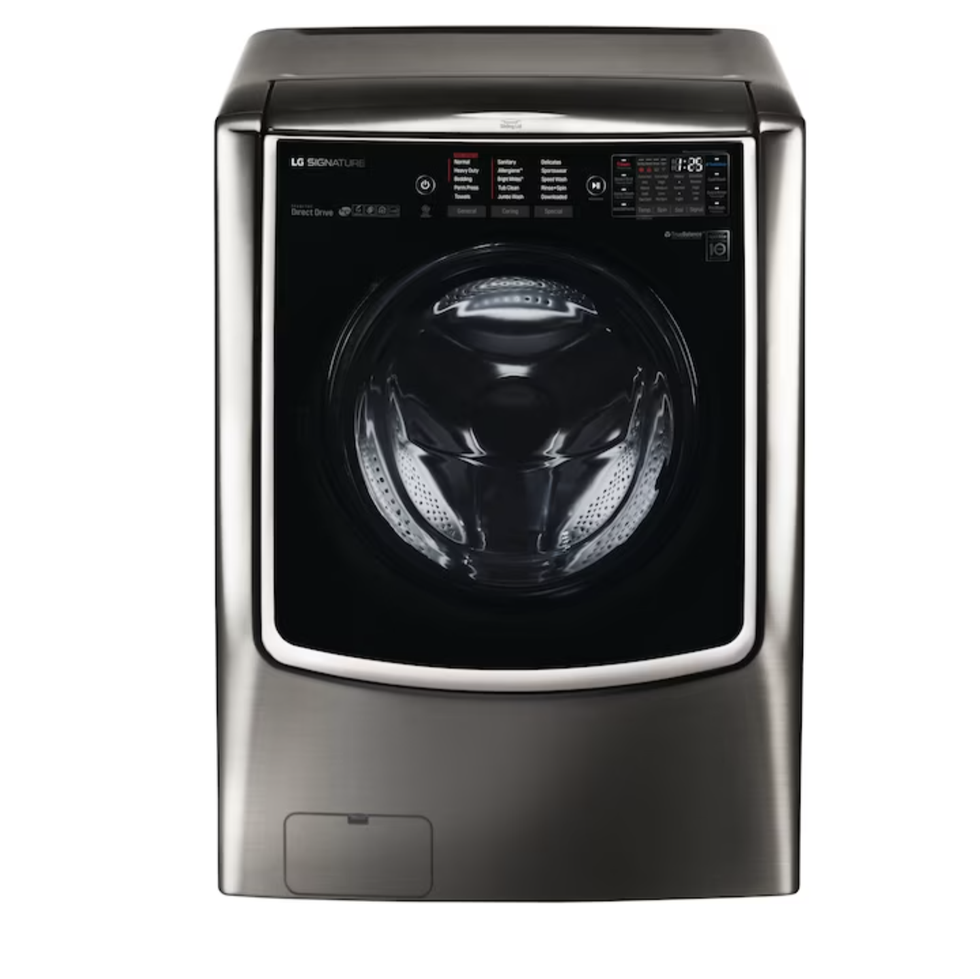
LG Signature High-Efficiency Smart Front-Load Washer
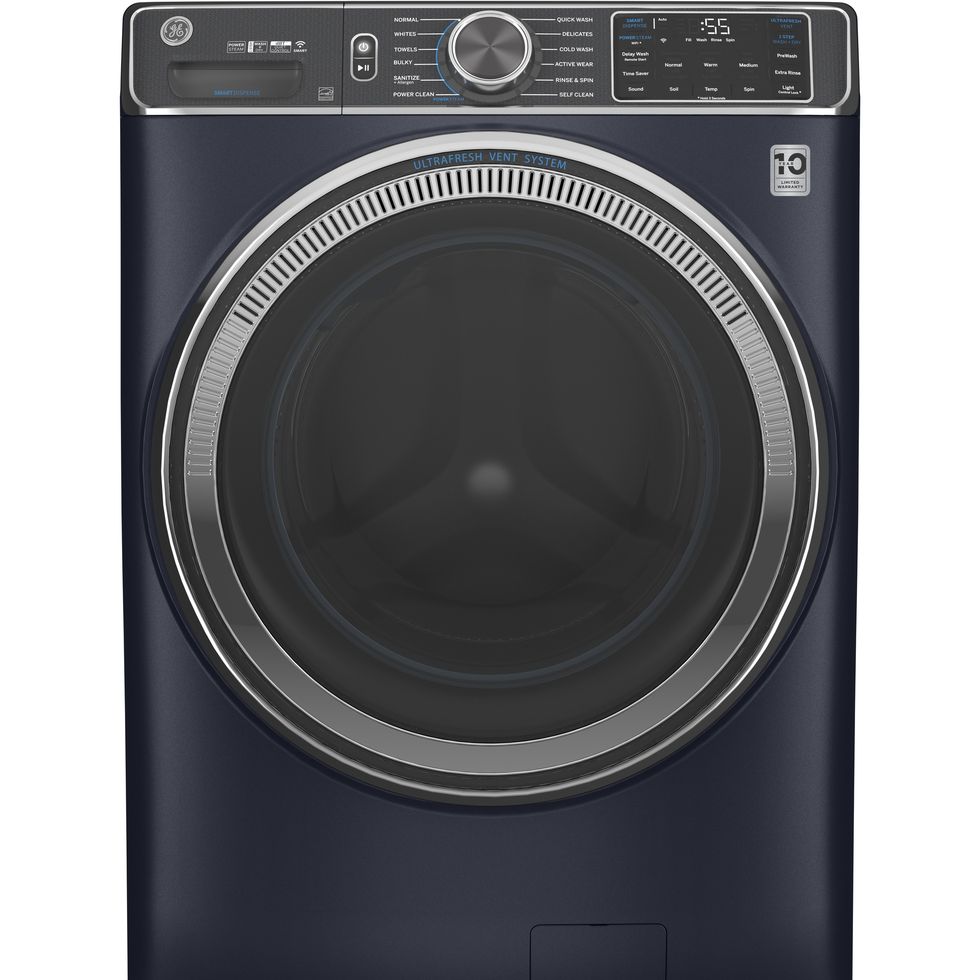
GE UltraFresh Front Load Washer with OdorBlock
Over the last 20 years or so, front-load washers have become much more popular in the United States. These horizontal-axis machines tumble and drop clothing through a small pool of water in a center drum.
Pros of a front-load washer
- Can be stacked: If space is at a premium, a front-loading washing machine can be stacked with its matching dryer and placed in a closet, bathroom or any small space where water, electrical connections and venting are available. (Note: Non-venting dryers are becoming more widely available, and our preliminary tests show their performance rivals that of vented models.)
- More energy-efficient: Front-load washers use the least amount of water during each load, making them the more energy-efficient choice. The machine senses the weight and type of load, then tumbles clothes in a small pool of water.
- Can handle large items: A front loader can easily handle big, bulky items, like pillows, comforters and sleeping bags.
Cons of a front-load washer
- More susceptible to mold and odors: At the end of a cycle, w ater can often puddle in the door gasket of a front-load washer, dispensers and even the drum itself. This can lead to mold growth and odors. If you opt for a front loader, it's important to be diligent about cleaning the gasket and dispenser. We also recommend leaving the door ajar or drying the machine. There are some newer machines that have features like venting and Microban technology to help address this issue.
- Can vibrate loudly: Some front loaders tend to vibrate very loudly during the high-speed spin cycle.
- May need a pedestal: A front-loading washing machine requires the user to bend down to load and unload laundry. If the washer's manufacturer makes them, a pedestal (typically sold separately) that raises the machine several inches can help avoid back strain by making the door easier to reach. Some even offer storage space for laundry products.
Main differences between front-load and top-load washers
Cleaning performance.
In our Lab tests, front-loading washing machines outperformed top-loaders, but only minimally. Our pros say you'd probably never know the difference — unless you regularly wash very large loads, since front-loaders are more equipped to handle bulky items.
Energy and water usage
Today's top- and front-loading washing machines are both more energy-efficient than their predecessors, but front-loaders use less water, giving them the edge.
In general, top-load machines are slightly less expensive than top-loaders, which tend to be packed with more pre-programmed cycles and smart features.
Which is better: a top-load or front-load washer?
Front-load washing machines performed slightly better in our Cleaning Lab tests, but both types clean so well that it's unlikely you'd notice a difference in your laundry. At the end of the day, it really comes down to personal preference.
Front-load washers typically require more maintenance to keep them mold- and odor-free, but are slightly more energy efficient and tend to come equipped with more smart washing machine features. Top loaders have a traditional design that’s low maintenance and easy to access without bending. On the downside, they can be actually be too deep for some smaller users. Also, remember: Only front-loading washing machines can be stacked with a dryer.
Why trust Good Housekeeping?
Carolyn Forté has been testing washers, dryers and other laundry room essentials, like laundry detergents and stain removers, for more than 40 years in the Good Housekeeping Institute's Home Care & Cleaning Lab. She often consults with the appliance industry, especially washing machine manufacturers, about appliance testing protocols and consumer laundry habits. She also researches and writes our laundry how-tos and personally tests or oversees all testing done for the Cleaning Lab's product guides.
Brigitt Earley is a writer, editor and content creator with over 15 years of experience in the home and cleaning spaces. She's no stranger to laundry day, either — she runs clothes for a family of six through her front-loader just about every day of the week. She put together this explainer on front-load vs. top-load washers under Forté's guidance.
Brigitt is a writer, editor and craft stylist with nearly 15 years of experience. She specializes in lifestyle topics, including home, health, parenting, beauty, style, food, entertaining, travel and weddings. She has written for Glamour, People, Good Housekeeping, Women's Health, Real Simple, Martha Stewart, Apartment Therapy, The Spruce, and more.
Carolyn Forté brings more than 40 years of experience as a consumer products expert to her role as executive director of the Good Housekeeping Institute 's Home Care and Cleaning Lab. Using deep analytical testing and writing expertise in appliances, cleaning, textiles and organizational products, she produces cleaning and home care advice for GH, has authored numerous books and bookazines for the brand and partners with the American Cleaning Institute to co-produce the Discover Cleaning Summits. She holds a bachelor's degree in family and consumer sciences from Queens College, City University of New York.
@media(max-width: 64rem){.css-o9j0dn:before{margin-bottom:0.5rem;margin-right:0.625rem;color:#ffffff;width:1.25rem;bottom:-0.2rem;height:1.25rem;content:'_';display:inline-block;position:relative;line-height:1;background-repeat:no-repeat;}.loaded .css-o9j0dn:before{background-image:url(/_assets/design-tokens/goodhousekeeping/static/images/Clover.5c7a1a0.svg);}}@media(min-width: 48rem){.loaded .css-o9j0dn:before{background-image:url(/_assets/design-tokens/goodhousekeeping/static/images/Clover.5c7a1a0.svg);}} Product Reviews

Best Mattresses for Back Pain 2024
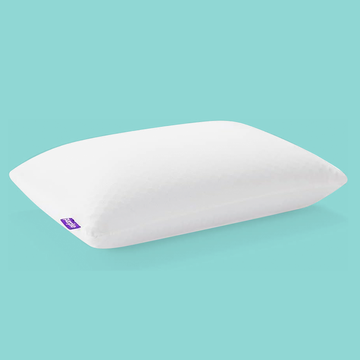
The Best Pillows to Get Rid of Neck Pain

The Best Online Flower Delivery Services

The Best Anti-Aging Creams
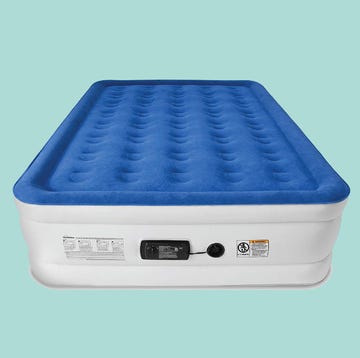
The Best Air Mattresses
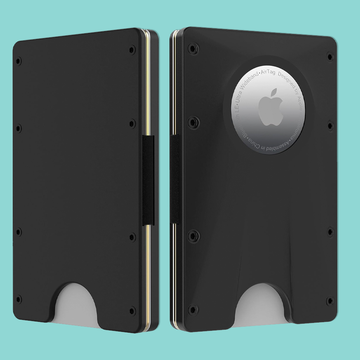
The Best AirTag Wallets
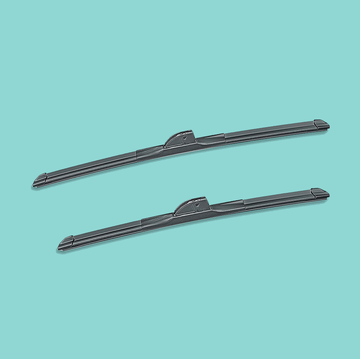
The Best Windshield Wipers

The Best HEPA Vacuums
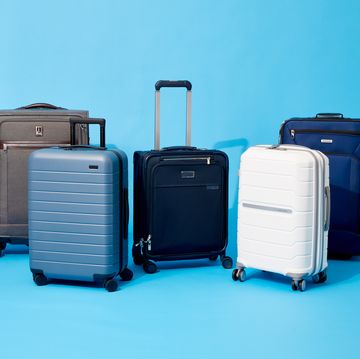
The Best Luggage Brands
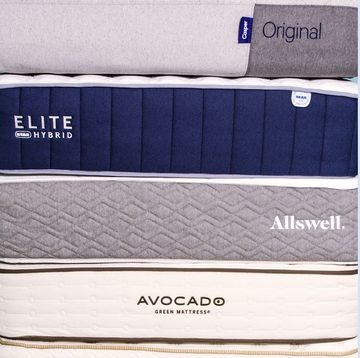
The Best Mattresses

The Best Mattresses You Can Buy Online

Seven Things You Didn’t Know Come in Travel Size
O ne of the quirks about travel is how your whole world shrinks—time gets short, airplane seats are smaller than ever , and many of the everyday products you use suddenly become “travel size.” You might be surprised, though, to discover just how many travel size products there actually are out there—heck, there’s an entire “superstore” dedicated to travel size products called Minimus , where you can find just about anything you need in tiny, adorable portions.
While most of us know you can find plenty of food, toiletries, and other basics in travel sizes, the wonders of the free market mean you can find some pretty surprising things designed to fit in your luggage. Here are several things you probably didn’t know come in travel size.
CPAP machines
If you suffer from sleep apnea or another breathing disorder and you regularly use a Continuous Positive Airway Pressure (CPAP) machine when you sleep, you know how difficult it is to travel with a bulky machine, and how much room it takes up in your luggage. Lucky for you, there are a lot of travel-sized options out there, like the ResMed AirMini . Approved for use on airplanes, this tiny unit is packed with useful features and is surprisingly quiet, so you won’t bother folks on the plane or in a shared hotel room. It’s not cheap, but if you travel a lot, it’s a great investment.
Musical instruments
If you’re a musician, you know that traveling with larger instruments can be a nightmare. Every few years the news reports another valuable instrument absolutely destroyed by airline , airport , or TSA employees, and shipping carries similar risks with additional costs. But if you just need a way to practice or simply enjoy playing and miss it when you have to leave home, the good news is that you can find a pretty wide variety of instruments in travel-size versions. There’s the Pocket Piano , which has a modular design that transforms from a small square to a full-size keyboard in moments, or the Hofner Shorty electric guitar, which offers a full-scale playing experience in a tiny little instrument.
Cocktail kits
Air travel can really cut into your cocktail hour—even if you have the time to relax with a drink, you’re often limited to whatever the flight crew can provide. But with a travel size cocktail kit (or three) you can enjoy just about any cocktail you like, from a Moscow mule to a mint julep, a mojito to an old fashioned. All you need to supply is the alcohol, and the kit provides everything else you need to keep it classy even in the cramped conditions of economy.
Coffee makers and kettles
Coffee, tea, and other hot drinks are usually pretty easy to find when you travel, but the costs can add up if you’re constantly grabbing to-go cups—plus, the quality of your beverages may not be quite what you’re used to. But you can actually pack your own espresso maker with the tiny-but-powerful Nanopresso , which requires nothing more than coffee and hot water to produce surprisingly terrific coffee. You can also find collapsible travel kettles that will let you brew up tea, hot chocolate, or any other warm beverage you’d like—and it squashes down and fits inside your luggage without a problem.
If you work out and travel a lot, you know the horrors of hotel gyms: lack of equipment, broken machines, or a crowd of people elbowing each other in irritation. But did you know you can actually pack weights to bring with you for an in-room workout? These travel dumbbells are a simple concept: Plastic weights you fill with water, offering up to 45 pounds of resistance in each one. Empty, they’re light and thin and fit easily into luggage or carry-on bags, and all you need to get a good workout is access to water.
White noise machine
Have trouble sleeping, especially in strange beds? Religiously use a white noise machine at home? Good news: You can buy travel size white noise machines like the Yogasleep Rohm —it’s tiny, but it sports great battery life and offers soothing white noise to block out the world. It comes with a strap that makes it easy to hang on your luggage or the seat in front of you, but can also be placed on a nightstand next to your bed to ensure a peaceful atmosphere and your best chance of getting some rest.
Clothes iron
No matter how careful while packing up your luggage, the chances that you’ll be spending your morning trying to steam your outfit in the hotel bathroom are not zero. While some hotels provide an iron in the room, that’s not always an option—but you can buy a travel-size iron that fits snugly in your bag, ready to be deployed at a moment’s notice.
Sign up for Lifehacker's Newsletter. For the latest news, Facebook , Twitter and Instagram .
Click here to read the full article.
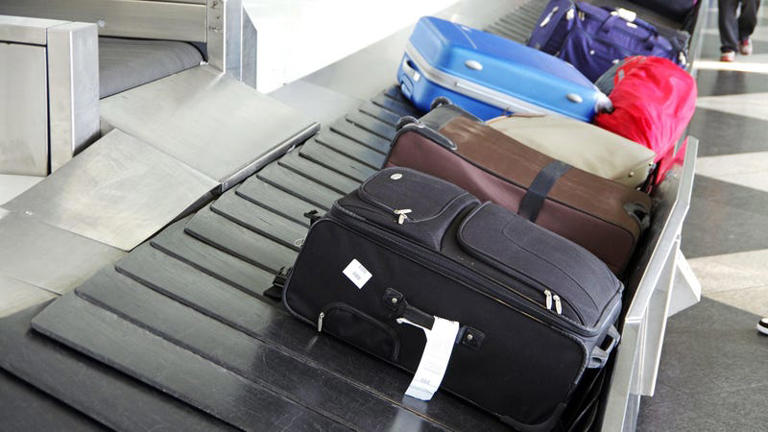
- Share full article
Advertisement
Supported by
NASA Picks 3 Companies to Help Astronauts Drive Around the Moon
The agency’s future moon buggies will reach speeds of 9.3 miles per hour and will be capable of self-driving.

By Kenneth Chang
NASA will be renting some cool wheels to drive around the moon.
Space agency officials announced on Wednesday that they have hired three companies to come up with preliminary designs for vehicles to take NASA astronauts around the lunar south polar region in the coming years. After the astronauts return to Earth, these vehicles would be able to self-drive around as robotic explorers, similar to NASA’s rovers on Mars.
The self-driving capability would also allow the vehicle to meet the next astronaut mission at a different location.
“Where it will go, there are no roads,” Jacob Bleacher, the chief exploration scientist at NASA, said at a news conference on Wednesday. “Its mobility will fundamentally change our view of the moon.”
The companies are Intuitive Machines of Houston, which in February successfully landed a robotic spacecraft on the moon ; Lunar Outpost of Golden, Colo.; and Venturi Astrolab of Hawthorne, Calif. Only one of the three will actually build a vehicle for NASA and send it to the moon.
NASA had asked for proposals of what it called the lunar terrain vehicle, or L.T.V., that could drive at speeds up to 9.3 miles per hour, travel a dozen miles on a single charge and allow astronauts to drive around for eight hours.
The agency will work with the three companies for a year to further develop their designs. Then NASA will choose one of them for the demonstration phase.
The L.T.V. will not be ready in time for the astronauts of Artemis III, the first landing in NASA’s return-to-the-moon program , which is currently scheduled for 2026 .
The plan is for the L.T.V. to be on the lunar surface ahead of Artemis V, the third astronaut landing that is expected in 2030, said Lara Kearney, manager of the extravehicular activity and human surface mobility program at the NASA Johnson Space Center.
“If they can get there earlier, we’ll take it earlier,” Ms. Kearney said.
The L.T.V. contract will be worth up to $4.6 billion over the next 15 years — five years of development and then a decade of operations on the moon, most of it going to the winner of this competition. But Ms. Kearney said the contracts allow NASA to later finance the development of additional rovers, or allow other companies to compete in the future.
The contract follows NASA’s recent strategy of purchasing services rather than hardware.
In the past, NASA paid aerospace companies to build vehicles that it then owned and operated. That included the Saturn V rocket, the space shuttles and the lunar roving vehicles — popularly known as moon buggies — that astronauts drove on the moon during the last three Apollo missions in 1971 and 1972.
The new approach has proved successful and less expensive for the transportation of cargo and astronauts to the International Space Station. NASA now pays companies, notably Elon Musk’s SpaceX, fixed fees for those services, more akin to plane tickets or FedEx shipments.
For the company chosen to build the L.T.V., the vehicle will remain its property, and that company will be able to rent it to other customers when it is not needed by NASA.
“It’s commercially available for us as a commercial business to sell capacity on that rover,” said Steve Altemus, the chief executive of Intuitive Machines, “and do that for international partners and for other commercial companies and space agencies around the world.”
The competition created alliances between small startups and larger, more established aerospace companies, as well as car companies. The Intuitive Machines team includes Boeing, Northrop Grumman and Michelin, the tire maker. Lunar Outpost added to its team Lockheed Martin, Goodyear and General Motors, which had helped design the Apollo moon buggies.
Astrolab is working with Axiom Space of Houston, which has sent private astronauts to the space station and is building a commercial module to the International Space Station. Astrolab announced last year that it had signed an agreement to send one of its rovers to the moon on a SpaceX Starship rocket as early as 2026. That mission is independent of whether it is selected by NASA, a company spokesman said.
While Lunar Outpost is competing with Intuitive Machines on this contract, it plans to work with the company separately, sending smaller robotic rovers to the moon on the company’s lunar landers.
Kenneth Chang , a science reporter at The Times, covers NASA and the solar system, and research closer to Earth. More about Kenneth Chang
What’s Up in Space and Astronomy
Keep track of things going on in our solar system and all around the universe..
Never miss an eclipse, a meteor shower, a rocket launch or any other 2024 event that’s out of this world with our space and astronomy calendar .
A new set of computer simulations, which take into account the effects of stars moving past our solar system, has effectively made it harder to predict Earth’s future and reconstruct its past.
Dante Lauretta, the planetary scientist who led the OSIRIS-REx mission to retrieve a handful of space dust , discusses his next final frontier.
A nova named T Coronae Borealis lit up the night about 80 years ago. Astronomers say it’s expected to put on another show in the coming months.
Voyager 1, the 46-year-old first craft in interstellar space which flew by Jupiter and Saturn in its youth, may have gone dark .
Is Pluto a planet? And what is a planet, anyway? Test your knowledge here .
Google will now let you use AI to build travel itineraries for your vacations
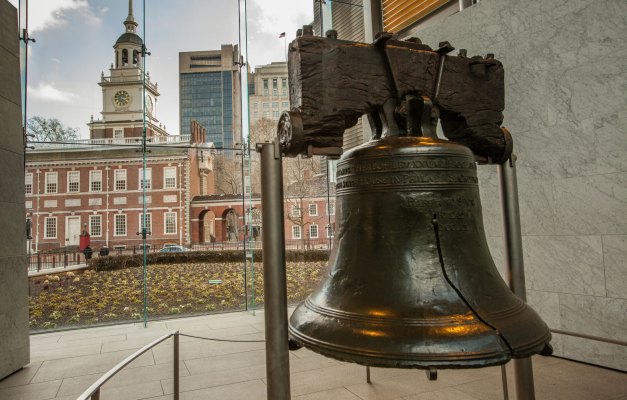
As we inch toward the summer holidays, Google is announcing a slate of travel updates that place it squarely in the travel planning process and give it a lot more insight into purchasing intent in the travel sector.
First up, Google is rolling out an update to its Search Generative Experience (SGE) that will allow users to build travel itineraries and trip ideas using AI, the company announced on Wednesday.
The new capability — currently only available in English in the U.S. to users enrolled in Search Labs , its program that lets users experiment with early-stage Google Search experiences and share feedback — draws on ideas from sites across the web, along with reviews, photos and other details that people have submitted to Google for places around the world.
When users ask for something like “plan me a three day trip to Philadelphia that’s all about history,” they will get a sample itinerary that includes attractions and restaurants, as well as an overview of options for flights and hotels, divided up by times of day.
For now, the itineraries are just that: There are no options to buy services or experiences on the spot. When you’re happy with your itinerary, you can export it to Gmail, Docs or Maps.
Google has not commented on when or if it might roll this out more widely. But it points to how the company is experimenting with how and where it can apply its AI engine. A lot of players in the travel industry may be eyeing up the role that generative AI will play in travel services in the coming years — some excitedly, some warily. But even now, startups like Mindtrip and Layla , which provide users with access to AI assistants that are designed to help you plan your trips, are already actively pursuing this.
But with this new update, Google is taking on startups like these while also gathering data about travel purchasing intent (useful for its wider ad business) and learning what kind of appetite its users might have for such services.
Image Credits: Google
Google also announced that it’s making it easier to discover lists of recommendations in Google Maps in select cities in the U.S. and Canada. If you search for a city in Maps, you will now see lists of recommendations for places to go from publishers like The Infatuation, as well as from other users. You will also see curated lists of top, trending, and hidden gem restaurants in 40+ U.S. cities.
Finally, the company is adding new tools to help you customize lists you create, so you can better organize your travel plans or share your favorite spots with your friends and family. You can choose the order the places appear in a list so you can organize them by top favorites or chronologically like an itinerary. Plus, you can link to content from your social channels.
Subscribe Now! Get features like

- Latest News
- Entertainment
- Real Estate
- LSG vs GT Live Score
- MI vs DC Live Score
- Election Schedule 2024
- Win iPhone 15
- IPL 2024 Schedule
- IPL Points Table
- IPL Purple Cap
- IPL Orange Cap
- Bihar Board Results
- The Interview
- Web Stories
- Virat Kohli
- Mumbai News
- Bengaluru News
- Daily Digest

Eid-ul-Fitr 2024 travel guide: 5 tips for navigating crowds and booking affordable getaways
Get ready to make the most of eid-ul-fitr 2024 with our essential travel tips, designed to help you navigate crowds and secure budget-friendly getaways..
It's that time of year again! Muslims will be celebrating Eid al-Fitr on April 10 with much fanfare and excitement after a month of fasting. Millions of people will be travelling to celebrate with friends and family, so it's important to plan ahead and shop around for the best deals to ensure a stress-free holiday . Typically, many of us will be travelling home for this joyous day (called 'mudik' in Indonesian). So, are you one of those making travel arrangements for this Eid ? Travelling during the holidays means more traffic at train stations, airports, etc. While travelling during Eid can be hectic and stressful, you can avoid the airport crowds and enjoy a hassle-free trip if you prepare in advance. (Also read: Eid-ul-Fitr 2024 travel: From Saudi Arabia to Indonesia, 7 top destinations to experience festive vibes )

Travel tips for Eid-ul-Fitr 2024
Here are some insights and recommendations to ensure a smooth and enjoyable travel experience during this festive season.
1. Book Your Accommodation in Advance
Extended Eid celebrations are often hectic and packed with activities, with hotels, resorts and other hospitality venues booking up well in advance. We recommend that you book your accommodation as far in advance as possible if you want to be sure that your family will have a place to stay when they come to visit. This will help to avoid disappointment at the hotel of your choice. Similarly, if you are planning to visit another country in the Middle East or further afield, it is essential that you make your reservations well in advance.
2. Take Care of Your Personal Belongings
The Eid holidays offer a welcome break from our daily routines, which often involve long periods away from home. If you are travelling, you may be away from home for several days. Make sure your home is safe. Remember to switch off the oven and secure doors and gates. In order to preserve electricity and avoid short circuits, be sure that certain electronic gadgets are turned off. Do you commute by public transport? No problem. But remember to keep an eye on your belongings. To make sure nothing is left behind or taken by someone else, keep an eye on what you bring with you.
3. Browse For Good Eid al-Fitr Deals
In order to spark interest and draw customers for the Eid al-Fitr holidays, a large number of eateries and lodging options in the United Arab Emirates and the larger Middle Eastern region provide alluring offers and exclusive discounts. Check out your favourite restaurants, entertainment venues and accommodation providers' websites and social media pages for exclusive offers and promotions to maximise your savings.
4. Pack Light
When you are travelling over the Eid holiday, try to pack as little as possible. In addition to saving you time and frustration, packing light can help you avoid paying extra for additional luggage and have more flexibility when on vacation.
5. Purchase Travel Insurance
Remember to consider travel insurance as an important safety precaution when organising your Eid holidays. Travel insurance provides financial security and protection against unforeseen circumstances such as lost luggage, medical problems and trip cancellation. Having travel insurance will give you added peace of mind and the assurance that you are prepared for any unforeseen events that may occur while travelling. When choosing a travel insurance policy, make sure it meets your needs and provides comprehensive coverage for your Eid holidays.
Join Hindustan Times
Create free account and unlock exciting features like.

- Terms of use
- Privacy policy
- Weather Today
- HT Newsletters
- Subscription
- Print Ad Rates
- Code of Ethics
- Elections 2024
- India vs England
- T20 World Cup 2024 Schedule
- IPL Live Score
- IPL 2024 Auctions
- T20 World Cup 2024
- Cricket Players
- ICC Rankings
- Cricket Schedule
- Other Cities
- Income Tax Calculator
- Budget 2024
- Petrol Prices
- Diesel Prices
- Silver Rate
- Relationships
- Art and Culture
- Telugu Cinema
- Tamil Cinema
- Exam Results
- Competitive Exams
- Board Exams
- BBA Colleges
- Engineering Colleges
- Medical Colleges
- BCA Colleges
- Medical Exams
- Engineering Exams
- Horoscope 2024
- Festive Calendar 2024
- Compatibility Calculator
- The Economist Articles
- Explainer Video
- On The Record
- Vikram Chandra Daily Wrap
- PBKS vs DC Live Score
- KKR vs SRH Live Score
- EPL 2023-24
- ISL 2023-24
- Asian Games 2023
- Public Health
- Economic Policy
- International Affairs
- Climate Change
- Gender Equality
- future tech
- Daily Sudoku
- Daily Crossword
- Daily Word Jumble
- HT Friday Finance
- Explore Hindustan Times
- Privacy Policy
- Terms of Use
- Subscription - Terms of Use

IMAGES
VIDEO
COMMENTS
Ask fellow travelers for tips—most are happy to share their thoughts. A PD Cycler or NxStage Machine. Measure your machine in its travel case. A PD cycler may fit on a plane as a carry-on. If not, it will need to be checked. A NxStage System One can only be checked luggage. You can check one bag of supplies for free.
A travel size sewing machine is simply a fantastic choice if you such as to bring the machine along. It's great to be able to bring it conveniently as well as you can also use it for kids and also senior that can stagnate about with equipment . What to bring (excellent list for traveling.
Using a Travel CPAP Machine in Flight. Airlines must allow you to use a medically necessary device while you're flying. However, some of them require advance notice; check with your airline for ...
Set up your space and re-thread your machine. Before you jump into your projects and get on your sewing buzz… do a good once over on your machine and your supplies. Make sure it all made it with you. You'll also want to give a good once-over to your machine and threads. You may have left with it threaded correctly, but any travel trip is ...
When traveling with a sewing machine, it's important to be aware of and comply with the regulations and restrictions set by travel providers. Ensure needle security and protect fragile equipment by using a sewing machine travel bag or portable alternatives. Make sure your packaging meets TSA compliance guidelines, including waterproofing ...
Yes. You can bring your sewing machine on the airplane, as long as you remove any sharp objects and prepare it carefully by having it in a travel bag that can fit as hand luggage. But there are precautions you need to make in order to be sure you can bring it through security. [/su_note]
Level. 29 dBA. Weighing 10 ounces and with a small 20-watt AC power cord, the ResMed AirMini is a compact device that should easily fit into your travel bag. In addition to use on business trips and camping, this portable CPAP can be used on airplanes since it is FAA-approved for in-flight use.
Packing essentials for sewing machine travel. To ensure a smooth and hassle-free journey with your sewing machine, pack the essential items in a travel-friendly sewing machine case. Look for cases that provide protective padding to keep your machine safe during transit. Make sure there are secure compartments to store needle security and other ...
Bring your CPAP machine in its case as carry-on. Prepare to show appropriate documentation (pack with your machine). Turn humidifier off, and turn on airplane mode (if your CPAP machine has it). Share your story with us! If you've been on an airplane with a CPAP machine, we want to hear from you on Facebook or Twitter. Use hashtag #CPAPTravel.
Luna TravelPAP Travel CPAP Machine. $835.00 $1365.00. Compare. Add To Cart. Free Shipping. Save 43%. XT Auto CPAP Machine w/ Humidifier. ★★★★★. 141 Reviews.
When traveling with a CPAP machine, it is a good idea to pack backup parts and supplies, including your mask, tubing, and filters. In addition, bring extra batteries, a power adapter, and an extension cord. If you use a humidifier with your CPAP, you may want to bring distilled water or purchase distilled water after you land.
Your best bet is to pack your machine in your carry-on (checked bags go missing all the time) with an empty reservoir as you won't be allowed to carry it on with water in it. The TSA blog recommends placing your machine in a clear plastic bag within your carry-on as it will need to be placed in one of the x-ray bins provided yes, the same ...
Packing Your CPAP Machine - How to Travel with a CPAP Machine. When packing your CPAP machine, ensure it's well-protected. Consider purchasing a travel case designed specifically for CPAP machines. These cases typically include compartments for all your accessories and provide ample protection. >>Check Out Our Post on the Best Travel Bags ...
Traveling and Flying With Your CPAP Machine in 2024: Top 10 Tips and Checklist. Before Traveling: Test and check your CPAP equipment two weeks before your trip. Bring extra supplies and a copy of your CPAP prescription. Flying Essentials: Your CPAP machine is not counted as carry-on luggage.
Tips for preparing to travel with your CPAP equipment.
Here are some tips on how to do sewing while traveling: 1. Make sure you have a good quality sewing machine. You will need something that can handle heavy fabrics because it is going to be used for a long period of time. 2. Choose the right type of fabric for your project.
A nebulizer, CPAP, BiPAP and APAP must be removed from its carrying case and undergo X-ray screening. Facemasks and tubing may remain in the case. You may provide a clear plastic bag to place the device through the X-ray.
In fact, the TSA actively encourages sleep apnea patients to travel with their portable CPAP equipment. "Our officers are very familiar with CPAP machines and see them numerous times daily," the TSA blog team wrote in a 2011 article explaining CPAP air travel guidelines. The TSA goes on to recommend bringing your CPAP machine on the plane ...
The Best Travel CPAP Machines for 2024. ResMed AirMini - Editor's Pick. Transcend Micro Auto CPAP Machine - Best Lightweight Travel CPAP Machine. Breas Z2 Auto Travel CPAP Machine - Best Quiet Travel CPAP Machine. Apex XT Auto CPAP Machine - Best Budget Travel CPAP Machine.
Cost - Travel CPAPs are not particularly cheap and can cost between $450 to $1200. They are also less likely to be covered by health insurance. You may find devices that are cheaper, but the quality of the device is paramount as it needs to provide the benefits of your standard machine.
The cost of travel CPAP machines typically ranges from about $600 to $1,100, but some websites offer sale pricing. It's also important to note that some machines are sold with all necessary ...
Before booking your ticket, be sure to inquire about any rules or restrictions that may apply. Some trains may require advance notice or documentation from your doctor to allow you to use your CPAP machine onboard. Usually, this is not the case. Most travel companies must follow guidelines for travelers with medical conditions.
Travel Machine is an Authorized Disney Vacation Planner. Our agents have over 20 combined years of experience with planning trips to the happiest place on Earth! Domestic Travel We can book your flights, hotels, rental cars, entertainment, food, and more. Whether for business or pleasure, Travel Machine has your back, no passports required!
Pros of a top-load washer. Requires less bending and is easier to load: A front-load washing machine requires the user to bend down to load and unload laundry. With a top-loader, you can stand ...
Good news: You can buy travel size white noise machines like the Yogasleep Rohm—it's tiny, but it sports great battery life and offers soothing white noise to block out the world. It comes ...
NASA had asked for proposals of what it called the lunar terrain vehicle, or L.T.V., that could drive at speeds up to 9.3 miles per hour, travel a dozen miles on a single charge and allow ...
First up, Google is rolling out an update to its Search Generative Experience (SGE) that will allow users to build travel itineraries and trip ideas using AI, the company announced on Wednesday ...
Get ready to make the most of Eid-ul-Fitr 2024 with our essential travel tips, designed to help you navigate crowds and secure budget-friendly getaways. Prepare for Eid-ul-Fitr 2024 with our ...